N1 (original) (raw)

Home - Search - Browse - Alphabetic Index: 0- 1- 2- 3- 4- 5- 6- 7- 8- 9
A- B- C- D- E- F- G- H- I- J- K- L- M- N- O- P- Q- R- S- T- U- V- W- X- Y- Z
N1

N1 Evolution 1959-74
YaRD nuclear ICBM; YaKhR nuclear LV; SuperRaket; R-9 ICBM; N-III; N-IIGR; N-I of 1962; N1-L3 of 1964;N1F; N1M; N1F+Block S, R upper stages; N1F+Block Sr upper stage; Airbreathing N1 for MKBS
The N1 launch vehicle, developed by Russia in the 1960's, was to be the Soviet Union's counterpart to the Saturn V. The largest of a family of launch vehicles that were to replace the ICBM-derived launchers then in use, the N series was to launch Soviet cosmonauts to the moon, Mars, and huge space stations into orbit. In comparison to Saturn, the project was started late, starved of funds and priority, and dogged by political and technical struggles between the chief designers Korolev, Glushko, and Chelomei. The end result was four launch failures and cancellation of the project five years after Apollo landed on the moon. Not only did a Soviet cosmonaut never land on the moon, but the Soviet Union even denied that the huge project ever existed.
AKA: G-1;N-1;SL-15. Status: Retired 1972. First Launch: 1969-02-21. Last Launch: 1972-11-23. Number: 4 . Payload: 70,000 kg (154,000 lb). Thrust: 4,400,000.00 kN (989,100,000 lbf). Gross mass: 2,735,000 kg (6,029,000 lb). Height: 105.00 m (344.00 ft). Diameter: 17.00 m (55.00 ft). Apogee: 200 km (120 mi).
Before the N1 - 1955 to 1960
Before the N1 there was an attempt to develop launchers and ICBM's to put large payloads into orbit using nuclear thermal propulsion. The first official plan for future Soviet spaceflight was contained in a decree of 30 January 1956. This set forth the following objectives:
- Orbiting of satellites of 1.8 to 2.5 metric tons mass by 1958
- One-week flight of a manned spacecraft by 1964
- Unmanned reconnaissance satellite by 1970
- Rocket capable of 12 metric ton escape velocity payload by 1970
- Rocket with 100 metric ton low earth orbit payload, capable of placing 2 to 3 men on the moon (no date set)
The first approach to the rather vague last objective was the use of nuclear power. Korolev's OKB-1 began work on nuclear launchers and missiles on 30 June 1958. Competing engine designs were in development by Glushko's OKB-456 and Bondaryuk's OKB-670. The draft project designs of both bureaus used nuclear reactors in cylindrical housings, with the reactors operating at 3000 K. The propellant was heated in the reactor and exhausted through four expansion nozzles. The Glushko engine operated with ammonia, while the Bondaryuk engine used a mixture of ammonia and alcohol. With such propellants a specific impulse of 430 seconds at launch was expected. Three rockets were designed by OKB-1 utilizing these engines:
- The first variant, YaKhR-2, followed the layout of the R-7 ICBM. With a length of 48 m, it had six strap-ons using 36 conventional LOX-Kerosene Kuznetsov engines. The core of the missile used the nuclear engine. This ignited at altitude after burnout of the strap-ons with a thrust of 140 to 170 metric tons. Lift-off mass of the booster was to be from 850 to 880 metric tons, with an orbital payload of 35 to 40 metric tons.
- The second variant was an ICBM with a range of 14,000 km. Using the Bondaryuk engine this would have had a lift-off mass of 87 metric tons and a payload of 2.6 metric tons. With the Glushko engine the figures would have been 100 metric tons and 4 metric tons. Obviously testing of such a missile with a nuclear reactor being delivered to the impact zone together with the test warhead would have grave ecological consequences (even though it was anticipated that tests would impact into an artificial reservoir). Interestingly the existence of such a project was mentioned by the American spy Oleg Penkovskiy in 1961 - but considered absurd by Western experts until revealed by RKK Energia in 1996.
- The third variant designed was a 'Super Rocket' with a lift-off mass of 2,000 metric tons and a payload of 150 metric tons. This was a true antecedent of the N1. The first and second stages were in the conical 'raketov' form later adopted for the N1. The first stage used a massive cluster of Kuznetsov NK-9 engines each with a thrust of 52 metric tons. The second stage used four nuclear engines with a total thrust of 850 metric tons. Operating at an elevated temperature of 3500 degrees K a higher specific impulse of 550 seconds in vacuum was expected. Although ideal for use in nuclear rockets, use of liquid hydrogen as a propellant was not contemplated. A mixture of liquid hydrogen and methane was considered as a better-performance propellant at a later date.
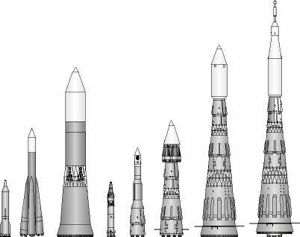
N1 Predecessors
Predecessors to the N1 - From left: YaRD nuclear powered ICBM; YaKhR nuclear launch vehicle; SuperRaket; R-9 ICBM; N-III; N-IIGR; N-I of 1962; N1-L3 of 1964
Work on this form of nuclear propulsion was abandoned at the end of 1959 when it became apparent that conventional chemical propulsion could provide nearly equivalent performance with less development, safety, and environmental risk.
Birth of the N-I
The space race with the Americans had heated up considerably since the casual program laid out in the plan of 1956 was issued. A decree of 10 December 1959 added a number of new programs, but for Korolev this was not enough. In a letter to the Central Committee of the Communist Part in January 1960 he proposed an aggressive program for Communist conquest of space. He declared:
- That the design bureaus of the Soviet Union must make a broad swift assault on space research
- That a new rocket of 1,000 to 2,000 metric tons gross lift-off mass with a 60 to 80 metric ton payload must be developed at the earliest possible date
- That advanced propulsion systems - nuclear, Lox-LH2, low thrust liquid, ion, and plasma engines and correction rockets - be developed as quickly as possible
- That new automatic and radio guidance systems be developed to support these objectives
The heavy rocket would be developed in two phases:
- N-I, with a 40 to 50 metric ton payload, to be developed as quickly as possible in 1960 to 1963
- N-II, with a 60 to 80 metric ton payload, using nuclear second and upper stages, to be developed in 1964 to 1965
As payloads for his rocket, to be developed in accordance of the Central Committee decree of 10 December 1959, the following would be developed for launch in the period 1963 to 1965:
- Three to six geostationary communications satellites of 2 to 3 metric tons mass for global communications
- Heavy manned space stations with a crew of 3 to 5, orbited at 350 to 400 km altitude. The station would conduct military reconnaissance, control other spacecraft in orbit, and undertake basic space research. The N-I version of the station would have a mass of 25 to 30 metric tons and the N-II version 60 to 70 metric tons
- Heliocentric satellite for solar studies of 1 to 2 metric tons mass
- Use of the N-I to launch a spacecraft with 2 to 3 men for flyby of the moon, entry into lunar orbit, and return to earth. Payload mass 10 to 12 metric tons in lunar orbit, 2 to 3 metric tons return payload.
- Use of the N-I to launch the MK interplanetary spacecraft with 2 to 3 crew on 2 to 3 year flyby missions to Mars and Venus. Automatic probes would be landed on the planets during the flyby maneuvers.
- Use of the N-II for group flight of 3 to 4 spacecraft on expeditions to land on Mars and Venus. Crew per spacecraft would be 2 to 3. One spacecraft would be a reserve to ensure the safe return of the crews to earth. These spacecraft would be placed by the N-II on their interplanetary trajectories at a velocity of 11.2 km-s, have a mass of 10 to 30 metric tons, with a return capsule mass of 3 to 8 metric tons.
- Global rockets that could bombard any point on earth with showers of nuclear warheads totaling 40 to 100 metric tons mass at ranges of 3,000 to 12,000 km
- Potential to establish a defensive space infrastructure that would annihilate any enemy satellites or rockets that flew over the territory of the USSR
- Photographic and electronic reconnaissance of every part of the earth
- Precision military navigation
For his part, Korolev and the other chief designers would pledge to support this overall effort by the development of draft projects and fundamental research work to validate and mature the necessary technologies. They would place before the Central Committee in the third quarter of 1960 comprehensive plans for development of the new projects. It was requested that that the Central Committee authorize the design bureaus to undertake these draft projects, and that the Ministry of Finance be directed to allow the bureaus to use reserve funds to finance the work.
Korolev also requested that a decree be issued to establish a USSR Institute of Interplanetary Studies. This would be a public body like the nuclear institute in Dubna, and would co-ordinate world-wide work on space research and technology. The decree was also to authorize publication in the USSR of an open scientific technical journal covering international exploitation of space and interplanetary research.
This letter was followed by a meeting with Khrushchev on the subject on 3 March 1960. Korolev believed it would be truly possible with backing from the very top to have a large rocket in the USSR in a very short span of time. Unfortunately at the meeting Korolev made a slip of the tongue he would always regret, admitting that his plan had not been agreed among all of the Chief Designers. This resulted in Khrushchev throwing the matter back for a consensus plan.
By 30 May 1960 Korolev was back with a plan that now included participation of his rivals, Chelomei and Yangel. Project codes were applied and some of the work Korolev had planned was now Chelomei's. The consolidated plan was as follows:
- N-I - (Korolev) - to be developed in 1960 - 1962. 40 to 50 metric tons payload to low earth orbit and 10 to 20 metric tons to Mars. Draft project to be completed by second quarter 1961.
- N-II - (Korolev) - to be completed in 1963 - 1967. 60 to 80 metric ton payload to low earth orbit and 20 to 40 metric tons to Mars. Draft project to be completed in 1962.
- KS - (Korolev) - Heavy manned spacecraft, 2-3 crew, to demonstrate rendezvous, docking, and controlled flight. To be developed in 1961 to 1963 (this would become Soyuz).
- KL - (Korolev) - Manned spacecraft for lunar flyby. To be developed in 1961 to 1964 (this would become the L1).
- KMV - (Korolev) - Interplanetary manned spacecraft for 2-3 crew, flyby of Mars and Venus. To be developed in 1962 to 1965 (this was the TMK-1).
- R-7 - Four-stage version of R-7- (Korolev) - 300 metric ton gross lift-off mass, available from 1960 for robotic lunar and interplanetary flights (this would be the Molniya booster)
- M - (Korolev) - Launch to Mars of 1M robot probes in September - October 1960 and 2M probes in 1962 (these Mars flights were attempted on this schedule)
- V - (Korolev) - Launch to Venus of 1V probes in January 1961 and 2V probes in 1962 (these Venus flights were attempted on this schedule)
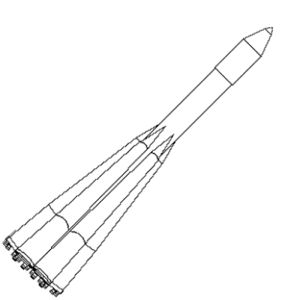
YaKhR-2 exterior
YaKhR-2 Nuclear-powered Launch Vehicle
Credit: © Mark Wade
E - (Korolev) - Launch to the moon (as per decree of 10 December 1959) E-1 lander probes in 1960 to 1961 and E-7 orbiters in 1961 (these lunar probes would eventually succeed many years behind schedule)- K - (Chelomei) - Development of unpiloted Kosmoplans for flight to Mars and Venus with return to earth and landing at conventional airfields. These would use new exotic chemical systems, low thrust nuclear engines (nuclear-plasma, ion, atomic hydrogen). Sub-variants with a total mass of 10 to 12 metric tons and 25 metric tons would be developed in 1965-1966. Draft project to be completed in 1962.
- UR-500 - (Chelomei) - Develop a 600 metric ton gross lift-off mass rocket using new chemical propellants for sending these spacecraft to nearby planets. Draft project to be completed in 1962. (This would become the UR-500 Proton booster)
- R-7L - (Korolev) - Develop in 1960 to 1962 a 4 stage version of the R-7, utilizing R-9 technology, with a 300 metric ton gross lift-off mass and high specific impulse engines in the last stage. Payload 10 metric tons to low earth orbit and 3 metric tons to escape. Draft project to be completed in 1961 (this booster, later called the Molniya-L, was never developed).
- Vostok recoverable spacecraft (Korolev) :
- Photo and electronic reconnaissance versions to be developed in 1960 to 1962 (these would be the Zenit-2 reconnaissance satellites. They would end up flying after, not before the Vostok manned flights)
- Manned version to be developed in 1961 to 1963 (these flew on schedule)
- Scientific research version to be developed in 1960 to 1962 (these were designed but never flown)
- Maneuverable rendezvous and docking version to be developed in 1961 to 1963 (this was the Vostok-Zh - never flown, replaced by Soyuz)
- Elektron - (Korolev) - high apogee radiation belt research satellites, developed according to decree of 10 December 1959, to be launched in 1960 to 1961 (these flew late to schedule)
- US - (Chelomei) - Naval reconnaissance satellite using P6 nuclear reactor. To be developed in 1962 to 1964 (these flew late to schedule)
- R - (Chelomei) - Manned Raketoplan spacecraft for orbital maneuvering flight and recovery at conventional airfields. Total mass to be 10 to 12 metric tons, total gliding range during re-entry 2,500 to 3,000 km. Unpiloted version to be developed in 1960 to 1961, followed by piloted version in 1963 to 1965. Satellite interceptor operational version to be tested in 1962 to 1964 (only suborbital subscale tests were conducted on this program before it would be cancelled)
- Meteorological satellites - (Korolev) - Meteor R-7 launched satellites to be developed in 1961 to 1963 (these would fly, but behind schedule), to be followed by heavy-rocket satellites in 1963 to 1964 (designer not decided).
- Communications satellites - (Korolev) - R-7 launched satellites to be developed in 1961 to 1963 (these would fly, behind schedule, as the Molniya series), to be followed by heavy rocket satellites in 1962 to 1964 (designer not decided).
- DS - Small satellites - launchers - (Yangel) to be developed in 1961 to 1965, together with launch vehicles derived from the R-12 and R-14 ballistic missiles (this program flew on schedule)
- OS - (Korolev) - Space stations - the Ministry of Defense was to decide by the fourth quarter of 1960 whether it can utilize military stations with multiple independent rocket-warheads
- IS - Antisatellites - the Ministry of Defense was to decide by July 1960 whether to develop an R-7 launched system for annihilation of enemy reconnaissance satellites (this project was conducted, but given to Chelomei for launch on the UR-200. Eventually flew in the late 1960's, launched by Yangel Tsiklon rockets)
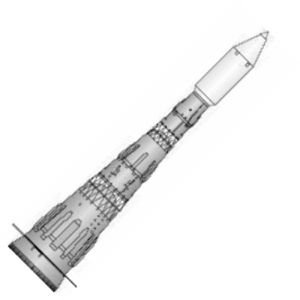
N1 - 1962
N-I as per draft project, 1962
Military Communications Satellites - the Ministry of Defense was to decide by the fourth quarter of 1960 whether to proceed with development of military communications satellites (this was done - the Strela series)- GOSPLAN was to allocate budget beginning in 1961 for development of the systems set forth in the plan The Chief Designers almost immediately began jockeying to change the plan. Glushko advocated development of heavy rockets by his OKB in place of those of Korolev. He proposed using rocket engines derived from his R-9 141 metric ton thrust four chamber engine. His R-10 would have a total lift-off mass of 1,500 metric tons, and be followed by an R-20 with 2,000 metric tons. He advocated nitric acid-UDMH storable propellants in the first stage and higher-performance Lox-UDHM propellants in the upper stages. Later Lox-LH2 upper stages would be introduced for even higher performance. He also requested to pursue development of a 100 metric ton thrust chamber; Korolev derided the idea, believing Glushko could not accomplish it.
However the May plan was approved as outlined. Therefore N-I design officially began as a result of the final government decree 715-296 of 23 June 1960 'On the Production of Various Launch Vehicles, Satellites, Spacecraft for the Military Space Forces in 1960-1967'
Design of the N-I
The same day that the decree was issued Korolev wrote to the Ministry of Defense, again trying to obtain support for a military orbital station (OS), on which a decision had been deferred to the end of the year. He pointed out that his design bureau had already completed a draft project, in which 14 work brigades had participated. Missions the station could accomplish included:
- Reconnaissance
- Combat operations against enemy spacecraft
- Strike against any point on earth
- Communications and relay functions
- Military applications studies
- Defense against enemy ballistic missiles
- Study of the space environment
- Study of the earth and planets
- Astronomical observations
- Weather observation
- Interorbital communications
- Study of the sun
- Biological research
- Radiation control studies By September 1960 Korolev's engineers had already settled on the N1 configuration they would defend formally in the review of the draft project nearly two years later: a monoblock 'carcass' scheme with a total lift-off mass of 2,000 metric tons and a payload of 70 to 75 metric tons. Propellants considered included Lox-Kerosene, Lox-UDMH and Nitric Acid-UDMH. Polyblock variants were considered, but the resulting 30 propellant tanks were too complicated. The selected design would be monoblock, with spherical tanks, 10 to 11 m in diameter. At this point they were still investigating use of 170 metric ton, 300 metric ton, and 600 metric ton thrust engines. The N-I was expected to have a payload of 3 to 4 % of its takeoff mass, and the nuclear N-II 6 to 8%.
By this time Glushko had new data from the US on the use of N2O4 (nitrogen tetroxide) as an oxidizer. He told Korolev that he advised replacing both Lox-UDMH and Nitric Acid-UDMH with N2O4-UDMH in the three stages of the N1. N2O4 would improve the specific impulse by 13 seconds at sea level and 14-15 seconds at altitude in comparison with the previously considered propellant combinations. To utilize it an existing turbine design would have to be increased from 25,000 to 30,000 HP, powered by a closed cycle gas generator cycle, and an increase in chamber pressure from 260 atmospheres to 300. N2O4 was more stable than nitric acid, and cost 50 to 55 rubles per metric ton. For fourth stage applications, Glushko recommended use of a 10 metric ton engine burning hydrogen peroxide and pentaborane. Although extremely difficult to handle and toxic, the propellants would increase the specific impulse by 54 seconds compared to nitric acid-UDMH, 40 seconds compared toN2O4-UDMH, and 25 seconds compared to Lox-Kerosene. Korolev was not at all receptive to use of any of these propellants, still preferring Lox-Kerosene.
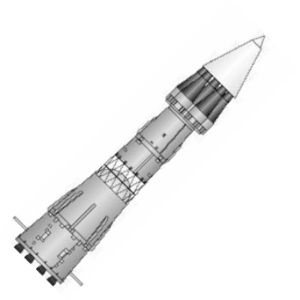
N-IIGR - 1962
N-IIGR Multi-Warhead FOBS, 1962
By March 1961 four design bureaus were working on development of rocket engines for the N-I and N-II. Glushko and Kuznetsov were competitively developing engines (RD-250 and NK-15) for the N-I. Isayev and Lyulka were working on advanced Lox-LH2 engines for later N-I upper stage applications. Glushko and Bondaryuk were designing new nuclear engines using LH2 propellant for the N-II.
Glushko really saw the adoption of the N2O4-UDMH propellant combination as the answer to problems he had experienced with combustion instability and chamber cooling in the four-chamber RD-111 engine developed for Korolev's GR-1 ICBM. As was the case with the R-7, Glushko was unable to solve the problems and finally resorted to four smaller chambers operating from a single turbopump. This scheme provided problems of its own, however - difficulties in synchronizing the thrust of the four chambers. By using N2O4-UDMH, a combustion chamber 280 to 580 degrees less than that of Lox-Kerosene would be obtained, greatly lessening these problems and allowing faster development.
Korolev had nothing but contempt for Glushko by this point, going back to his belief that it was Glushko's denunciation of him in 1937 that landed him in the Gulag, in the death-mines of Kolyma. Glushko had failed to solve combustion problems with the RD-105 engine, forcing the use of a four-chamber design in the RD-107 and RD-108 - chambers little larger than those on the V-2. Glushko had refused to solve the vernier rocket design for the R-7, forcing Korolev to do it. Glushko had been unable to expediently provide an upper stage engine for the R-7, forcing Korolev's own bureau to develop the S1.5400. Again with the R-9 engines, Glushko could not solve the problem of producing stable combustion in a large chamber.
In developing the S1.5400 Korolev's team demonstrated the higher performance that could be achieved with a closed-cycle engine. Glushko refused to consider this for a Lox-Kerosene RD-250 - it would only increase the already unmanageable chamber pressures and temperatures. Therefore Korolev turned to Kuznetsov's design bureau. Kuznetsov's OKB had originally been founded to exploit German engineers and develop the gigantic turboprop engines of the Tu-95 Bear bomber. But with assistance from Korolev's team he promised he could learn the technology. Kuznetsov had good relations with Korolev and was conveniently located in Samara, the same town where R-7 production was underway and N-I production was planned. Kuznetsov was willing to attempt to produce the higher-efficiency closed cycle engine that Glushko believed was impossible with the Lox-Kerosene propellants.
By March 1962, faced with Chelomei's favor with the military, Korolev made a detailed pitch for development of the N-I in the military context. This evolutionary program had a real chance of producing a mature launch vehicle for heavy applications.
Korolev proposed first to develop the N-II and N-III, based on the upper stages of the N-I. These would initially use the NK-9 engines developed for the R-9 and GR-1 rockets.
Step 1 would be the N-II, which would fulfil the GR-2 global rocket requirement in place of Chelomei's UR-500. It would have a gross lift-off mass of 750 metric tons, and deliver a 25 metric ton payload to low earth orbit. It could also deliver a 25 megaton bomb from an under-the-radar orbital trajectory with an accuracy of 2 km. The N-11GR variant was an adaptation of the basic N-11, derived from the second and third stages of the N1 heavy booster. The GR-2 was to be a kind of enormous multiple-warhead FOBS (fractional orbit bombing system). Surrounding the top of the second stage of the rocket, like bullets in an enormous revolver, were six final stages derived from the 8K713 GR-1 last stage. Each stage had a 1,500 kg 2.2 MT nuclear warhead. The stages would separate from the main vehicle, and make violent maneuvers using independent guidance systems to put each warhead in a different low 160 km altitude orbit. At the end of a 10,000 to 12,000 km journey along their separate orbital paths, the warheads would appear on US radar screens at the last moment with minimal warning. The total spread of the warheads would be 1800 km from left to right; two such global rockets could devastate America's major cities from coast to coast in an unstoppable first strike.
Step 2 Would be to develop the first stage of the N-I, which coupled with the already-tested N-II would provide a total lift-off mass of 2,100 metric tons and put 80 metric tons into low earth orbit. Missions for the N-I would include global reconnaissance, anti-satellite, antiballistic missile, interceptor spacecraft to rendezvous with, examine, and neutralize enemy satellites; and nuclear anti-satellites.
This program could be conducted at minimum cost and risk. The NK-9 would be flight-tested by the end of 1963 in the improved R-9M ICBM. If the military could not afford construction of a new launch site, Korolev proposed that the N-II could be assembled in the existing R-7 MIK assembly hall and launched from the two R-7 launch pads at Baikonur, LC-1 and LC-31. Using this cut-rate approach the N-II could be developed for 2 million rubles and provide real confidence that the N-I would be successful. Korolev promised that if a prompt go-ahead was received the N-I would make a first flight by the end of 1964 or the beginning of 1965.
Despite this appeal, which set forth a program which could have discovered and eliminated the problems the N-I encountered later, the military did not support it. Chelomei was given go-ahead on 24 April 1962 to develop the UR-500 rocket for the GR-2 requirement.
Korolev's next attempt to win military support for development of the N-I was his fantastic 'Orbitalniy Poyas' (OP -Orbital Belt) scheme of 20 April 1962. Anticipating Ronald Reagan's Strategic Defense Initiative by 25 years, he painted a picture of an invincible Soviet space force patrolling the heavens. Two to three large N-I launched military manned stations would control a constellation of strategic assets. Geosynchronous nuclear-powered satellites would provide secure communications. Piloted reconnaissance spacecraft would surprise the enemy, observing military preparations without warning. The orbital stations would provide continuous observations of the territory of the imperialist block. They would control combat sputniks, maneuverable anti-satellites that would control the heavens from altitudes of 300 to 2,000 km. Using docking methods, the stations would be remanned, providing fresh crews to control anti-ballistic missile interceptors in 150 to 100 km orbits and to deploy separately targetable warheads at a variety of altitudes.

N1 early concept
Credit: © Mark Wade
There is no evidence the military was any more impressed with this justification than those previously put forth.
In parallel with the formal N1 draft project, since 1961, the Yangel and Chelomei bureaus had been developing alternate designs (Yangel's was designated R-56 and Chelomei's was the UR-700). Both used clustered 4 m diameter rocket stages. Both advocated each stage be equipped with a single large Glushko engine using toxic storable propellants and with a thrust of 450 to 550 metric tons. Such stages could be built in factories in Moscow or Dnepropetrovsk and shipped on the existing Soviet rail system to Baikonur. There they would be joined together but no actual metal fabrication work would have to be carried out. This approach was used with success for the smaller R-7 and Proton launch vehicles. Dynamic testing of scale models by TsNIIMASH indicated the clustering of large numbers of stages was feasible.

R-56 test model
R-56 dynamic test model
Credit: © Mark Wade
N-I Draft Project - 1962
The N-I draft project was completed on 16 May 1962. The design was defended before the other Chief Designers on 2 to 16 July 1962. And this is what the draft project said:
The three stage N-I was designed to support the following objectives:
- Placement of heavy spacecraft in low earth orbit for the purposes of research into the space environment; the origin and evolution of the planet Earth; solar radiation; the nature of gravity; physical observations of nearby planets; understanding the origin of organic life and the evolution of life on earth; etc.
- Circumnavigation of the moon with a crew of two to three men; entry into lunar orbit of robotic and crewed modules for study of the lunar surface
- Expeditions to the surface of the moon for the study of its soil, relief, inner structure, physical properties, and selection of a suitable site for a research base on the moon
- Establishment of a lunar base and regular traffic between the earth and the moon;
- Flyby of Mars and Venus and return to earth by a crew of two to three men
- Entry into orbit around Mars and Venus and return to earth of spacecraft with two to three men
- Delivery of expeditions to the surfaces of Mars and Venus and identification of sites for research bases
- Launch of automatic probes to the outer planets (Jupiter, Saturn, etc.)
- Establishment of manned and unmanned spacecraft in high and geosynchronous earth orbits, not obtainable by launch vehicles derived by ICBM's, for radio and television communications, earth resources, early warning, and meteorological purposes
- Deployment of heavy automatic and piloted military stations for high priority operations in earth orbit, including the capability of making evasive maneuvers and deployment of large numbers of nuclear warheads or other military apparatus in low earth orbit
- Simultaneous launch from a single base of a large number of nuclear warheads on intercontinental ballistic and global orbital trajectories, with the assistance of multiple independently-guided final rocket stages atop the last stage of the N-I In building the rocket to attain these objectives the following additional national objectives would be met:
- Construction of a launch vehicle of the highest possible payload
- Development of the national technical base to the highest possible degree
- Development of a family of smaller rockets using the same technology
After extensive study it was determined that the design objective of a single launch payload of 75 metric tons into a 300 km orbit best met the required payload masses for a variety of missions:
- Manned lunar orbiter
- Manned lunar landing, if used with Lox-LH2 upper stages
- Manned flyby of Mars and Venus
- Manned expeditions to orbits around Mars and Venus, utilizing two N-I launches, docking in earth orbit, and nuclear electric propulsion for the spacecraft
Many trade studies were conducted comparing differing propellants and design layouts before settling on the configuration set forth in the draft project as the optimum design. These trade studies would be vital in defending the design before the expert commission against the attacks of Glushko. Propellant variants studied were:
- N1-K, the baseline, using Lox-Kerosene (TG-1) in all three stages
- N1-V1,V2,V3: Variants with Lox-LH2 stages. These later developments could reach 120 metric tons to 165 metric tons low earth orbit payloads needed for manned Mars expeditions.
- N1-D-A: Variant with storable N2O4-UDMH propellants. Other less energetic propellant combinations considered were OKA-50-UDMH, Nitric Acid (AK-27)-UDMH.
Conclusions were that the highest specific impulse was obtained from the Lox-Kerosene combination; and that highest tank mass was required for the N2O4, OKA-50, or AK-27 oxidizers. Use of N2O4-UDMH would result in a reduction in specific impulse of 17 to 21 seconds compared to Lox-Kerosene and a reduction in payload of 20 to 25%. Use of AK-27-UDMH would result in a 33 to 38% second reduction in specific impulse and a reduction in payload of 43 to 47%. Moreover the storable propellants would cost almost ten times more than lox-kerosene (2 million rubles per N1 launch versus 250,000 rubles). These considerations, plus the easier handling of Lox-Kerosene, confirmed the propellant selection. Lox-LH2 engines would not be available during the time scale of the initial project, but would be considered later for uprated versions of the launch vehicle.
Configuration variations considered were:
- N1-I - Packet rocket, as used for the R-7. Six strap-ons around an identical core with an upper stage. Two sub-types were considered: In the first, as in the R-7, the rocket would hang from the 'shoulder' of the strap-ons above the flame pit to minimize lower stage mass. The second, which was selected for further study, had the same layout, but the base of the rocket was mounted conventionally, free-standing on its base on the launch pad. This was the baseline design for comparison with the others.
- N1- II - Polyblock - a cluster of autonomous rocket stages, each consisting of two propellant tanks feeding individual engine sections. Loads would be carried through the individual stage structure, although the Blocks would be tied together to form a single unit. This was basically the same as the competing Chelomei UR-700 and Yangel R-56 layouts.
- N1-III - Polyblock - a cluster rocket, but with the loads transmitted through an external skin. The tanks would be unsupported and a common fuel system would feed the engines. This scheme was analogous to the American Saturn I first stage and Nova designs.
- N1-IV - Monoblock - large single stages, each with one oxidizer and one fuel tanks, using a common fuel system to feed the engines. This was analogous to the American Saturn V and the selected N-I configuration
All of the designs used 'hot start' stage ignition, requiring use of the familiar Warren truss open strut interstages.
Following analysis of the designs, the following were the results of the detailed design analysis:
| Parameter | N1-I | N1-II | N1-III | N1-IV |
|---|---|---|---|---|
| Payload - kg | 70,000 | 65,000 | 72,000 | 75,000 |
| Complexity | 16 tanks8 engine systems78 armatures | 30 tanks15 engine systems621 armatures | 30 tanks3 engine systems331 armatures | 6 tanks3 engine systems305 armatures |
| Train Cars Required | 26 | 21 | 33 | 43 |
The disadvantages of Variants I, II, and III were the large number of servicing ports, fueling ports, and check inspection points. It was felt that the lower complexity and higher performance of the monoblock Variant IV outweighed the much greater number of train-car loads of parts necessary. The gores of the spherical propellant tanks and panels of the side walls would be built in the factory in Samara and only final assembly of the launch vehicle would be undertaken at the cosmodrome.
In the United States launch from coastal Cape Canaveral permitted the 10 m diameter Saturn IC and Saturn II stages to be shipped by barge from the factories to the launch site. No such possibility existed for Baikonur, in the arid steppes of Kazakhstan. Alternate launch sites were considered (and some space engineers wistfully hoped for a launch site on the balmy Black Sea) but Baikonur remained the only possibility. Due to the geography of the Soviet Union there was no other launch location with relatively uninhabited downrange areas for impact of spent rocket stages.
By this analysis the selection of lox-kerosene propellants and the monoblock configuration were justified in the draft project. Indirectly the problems of polyblock designs like those of Yangel and Chelomei were considered and attacked.
For the 75 metric ton payload a gross lift-off mass of 2,000 to 2,300 metric tons would be required using only Lox-Kerosene propellants in all stages. It would be necessary to build a 150 metric ton thrust closed-cycle rocket engine for use in the launch vehicle (at that time the largest rocket engine chamber built in Russia was 40 metric tons, open cycle). 24 NK-15-11D51 engines would be used in the first stage, 8 NK-15V-11D52 engines in the second stage, and 4 smaller NK-19-11D53 engines in the third stage. Development of engines in the 600 to 900 metric ton thrust were studied but would have required development of new technologies and not been available during the project's time scale. A 150 metric ton engine was well sized for use in the second stage and the clustering of large numbers of them in the first stage could be managed through use of the KORD control system (an elaborate automatic system that would monitor engine health, shut down any failing engine and its opposite number, allowing continued operation of the cluster until the required stage performance was reached).
From the N1 stages two smaller launch vehicles would be derived. The N11 would use versions of the second and third stages of the N1, together with the third stage of the GR-1. This would have a lift-off mass of 700 metric tons and a 20 metric ton payload into low earth orbit. It was designed for the same missions as the Chelomei UR-500 Proton booster. The N111 would use derivatives of the third stages of the N1 and the second stage of Korolev's R-9 ICBM. This would result in a lift-off mass of 200 metric tons and a five metric ton payload, allowing it to replace the R-7 derived Vostok and Soyuz boosters.
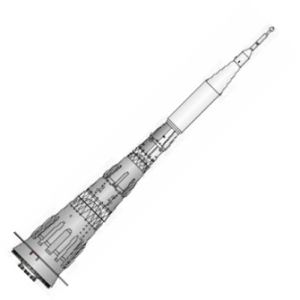
N1-L3 - 1964
N1-L3 as per advanced project, 1964
N-I Goes into Production
Despite intense criticism by Glushko, Keldysh and the rest of the expert commission supported the draft project. But the program was still without an authorized mission. Following the approval of the draft project there was a more informal discussion between Khrushchev and the Chief Designers at the Soviet leader's estate at Pitsunda, on the Black Sea, in August. Korolev went over the heads of the military once again and pitched his giant military space station as a rationale for the project. At the conclusion of the meeting, Khrushchev ordered start of the project to put a 75 metric ton manned platform with nuclear weapons into low earth orbit. The official decree authorizing N-I production was issued on 24 September 1962 with first flight to occur in 1965. This set forth the first of a series of optimistic schedules for development of the launch vehicle. Completion of third stage tests was expected by the end of 1964, first and second stages by mid-1965, completion of all engine test stand runs by the first quarter of 1965, completion of the launch complex by the end of 1964, and first launch in 1965.
So after two years of struggle, Korolev finally had his authorization in hand. But it turned out not to be enough. He had authorization for the rocket, but no support from the military ranks for a payload for it to launch.
Barmin's GSKB SpetsMash was given responsibility for design and construction of the launch facilities. In March 1963 design work started on the N1 launch complex. The ground-breaking ceremony was held a year later and construction began of the N1 launch complex and assembly buildings
Nuclear N-I's - 1961 to 1963
Following abandonment of the nuclear-ammonia ICBM projects, the engine bureaus of Bondaryuk (OKB-670) and Glushko (OKB-456) continued study of nuclear propulsion, but using liquid hydrogen for upper stage applications. Engines of 200 metric tons and 40 metric tons thrust with a specific impulse of 900 to 950 seconds were being considered. At the end of 1961 both bureaus completed their draft projects and it was decided to continue work on development of an engine in the 30 to 40 metric ton thrust range. In the following year Korolev was asked to study application of such engines, followed by a demand in May 1963 from the Scientific-Technical Soviet for specific recommendations.
Korolev considered three variants based on the N1:
- A three stage vehicle using the N1 first and second stages and a nuclear third stage
- A three stage vehicle using the N1 first stage and nuclear second and third stages
- A two stage vehicle using the N1 first stage and a nuclear second stage Considered for each case were nuclear engine designs Type A (18 metric tons thrust, 4.8 metric tons mass), AF (20 metric tons thrust, 3.25 metric tons mass), V (40 metric tons thrust, 18 metric tons mass), and V with a bioshield for use on manned flights (40 metric tons thrust, 25 metric tons mass).
The study concluded that the two stage vehicle was the most promising. Compared to an equivalent vehicle using liquid oxygen/liquid hydrogen, mass in low earth orbit would be more than doubled. Optimal stage size was 700 to 800 metric tons for the Type A engines and 1,500 to 2,000 metric tons for the type V engines (this resulted in a halaciously large number of nuclear engines by Western standards). Use of the nuclear stage would result in a single N1 launch being able to launch a round-trip lunar landing (mass landed on lunar surface over 24 metric tons with return of a 5 metric ton capsule to earth).
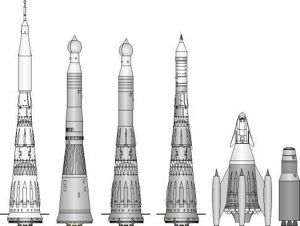
N1 Late Versions
Late versions of N1: from left: N1F; N1M; N1F with Block S, R upper stages; N1F with Block Sr upper stage; Airbreathing N1 for MOK support; Kistler
For a Mars expedition, it was calculated that the AF engine would deliver 40% more payload than a chemical stage, and the V would deliver 50% more. But Korolev's study also effectively killed the program by noting that his favored solution, a nuclear electric ion engine, would deliver 70% more payload than the Lox/LH2 stage.
Further investigation of nuclear thermal stages for the N1 does not seem to have been pursued. Bondaryuk and Glushko turned to Chelomei and his competing UR-700 rocket for future application of such stages.
N1 Payloads - the Moon Calls - 1963
On 23 September 1963 Korolev submitted his plans for space projects in the period 1965 to 1975. He now saw a clear chance to again appeal to the leadership for a manned lunar landing program. He dusted off his rejected L-1 circumlunar project, but added four new spacecraft that would allow reconnaissance, followed by landing on the moon and extended exploration of its surface.
The first two projects, as before, would use R-7 based launch vehicles and extensive docking and refueling operations in low earth orbit. But elements of these would be used in the last three, which would map the moon from lunar orbit, land men on its surface, and explore it with a manned crawler.
L-1
This revision to the original L1 project of 1962 had the same objective of sending two men on a circumlunar flyby trajectory. But now the Soyuz had a reverse configuration of that used earlier. From fore to aft, the modules were: the Descent Capsule (SA), Living Module (BO); Equipment Module (AO); Propulsion Module (AO); Rendezvous electronics module (NO) and Docking Unit (SU). This configuration would be important in the later N1-based projects. As before, the system consisted of the 7K manned spacecraft, the 9K rocket spacecraft, and the 11K tanker. A total of six launches of the 11A511 Soyuz booster would be required. The 9K rocket stage would be put in orbit first. It would be followed by four 11K tankers which would top off the tanks of the rocket block. Then, when all was ready, the 7K manned craft would be put into orbit and dock with the 9K stage. The stage would fire and put the manned spacecraft on a translunar trajectory.
The 7K would be equipped with cinema cameras and scientific sensors to record the lunar surface during the flyby, which would be at from 1,000 to 20,000 km from the lunar surface. Total flight time was 7 to 8 days. The SA would separate from the 7K at 120 to 150 km altitude and re-enter the earth's atmosphere at 11 km/sec. After decelerating to subsonic speed, the SA's parachute would open at 10-18 km altitude. Total mass of the L1 in low earth orbit was 23,000 kg and the flyby mass of the Soyuz alone was 5,100 kg.
L-2
The L2 was a project to land a remote-controlled self-propelled rover on the surface of the moon. It would use the same rocket stage and tanker elements developed for the L1 manned circumlunar project. It can be seen to be the direct ancestor of the Ye-8 Lunokhod lunar rovers of the 1970's.
The objective of the L-2 would be to conduct scientific research on the lunar surface and to allow selection of a favorable landing point for later manned flights. A television system would send back panoramic television pictures. The rover would be nuclear-powered and equipped with a radio beacon for later manned expeditions to home on for precision landings. It would also investigate:
The relief of the lunar surface
The mechanical properties of the lunar soil
The microscopic structure of the surface
The magnetic fields of the moon
Cosmic ray flux
Solar insolation at the surface
The L-2 system consisted of:The L-2 crawler. This had a maximum speed of 4 km/hour and a range of 2,500 km. The L-2 consisted of:
- Motor compartment with equipment permitting speeds of up to 4 km/hour
- Equipment compartment, with on-board radio, navigation, and control systems
- Power generating system (evidently solar and/or radioisotope generators)
The 13K rocket system for midcourse corrections and lunar braking. This would brake the L-2 to a direct landing on the surface of the moon with no intermediate lunar orbit. It consisted:
- Braking stage, for midcourse corrections and the main braking impulse for the landing on the surface. This would ignite at an altitude of 200-300 km above the surface.
- The landing vehicle, with throttled engines, for the soft landing on the surface at a speed of only 2 to 4 m/s.
- The guidance system
- The maneuvering and guidance system for docking with the 9K in earth orbit, which was cast off before the translunar injection.
The 9K translunar injection stage for sending the L-2 towards the moon from the low earth assembly orbit. This was the Soyuz B rocket stage used on the L-1 project
Total mass of the L-2 + 13K + 9K complex at ignition of the 9K for translunar injection was 23,000 kg. Total mass of the L-2 and 13K in their translunar cruise configuration was 5,000 kg. As was the case for the L-1, six launches of the Soyuz 11A511 booster would be required to assemble the L-2 in a 225 km low earth assembly orbit.
L-3
Korolev's first version of the L-3 manned spacecraft was designed to make a direct lunar landing using the earth orbit rendezvous method. It was a 200 metric ton spacecraft requiring three N1 launches and a single Soyuz 11A5ll launch to assemble in low earth orbit. The first N1 launch would place the 75 metric ton partially-fueled TLI stage and L3 spacecraft (except the L1 manned return craft) into low earth orbit. Two further N1 launches would orbit 75 metric ton tankers which would rendezvous and dock with the first payload and top off its propellant tanks. Then the Soyuz would be launched for an automated rear-end docking with the entire L3 stack. The L3 spacecraft thereby assembled consisted of:Translunar injection stage, with a total mass of 138 metric tons
The lunar braking stage, which included a separate midcourse correction section cast off before the braking burn. Midcourse maneuvers would be made at 100,000 and 150,000 km from the earth to ensure a landing near the site pre-surveyed by the L-2 robotic lunar rover, which would be providing a homing signal for the L-3. The lunar braking stage had a total mass of just under 40 metric tons. The main braking burn would start 200 to 300 km above the surface.
The lunar soft landing/ascent stage, which had a total mass of 21 metric tons landed on the moon. The stage would use variable-thrust engines to make a soft landing at 2-4 m/s on the surface. The landing leg structure and soft landing engines would be left behind on the moon.
The ascent stage, which would separate from the landing legs and propel the manned capsule back toward the earth. This included the guidance system for the entire L-3 complex.
The Soyuz L1 manned spacecraft, which consisted of a 2.5 metric ton equipment module and 2.5 metric ton re-entry module. It could accommodate a crew of two to three.
The total L3 mission would take ten to seventeen days. 2.5 to 3.5 days would be spent on the translunar and transearth legs of the mission Five to ten days would be spent on the lunar surface.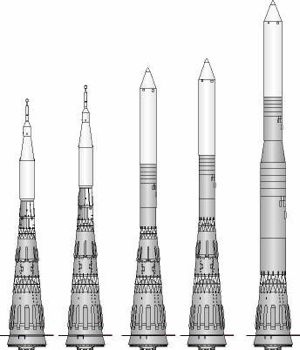
N-IF Variants
N-IF Versions, from left: N1-L3; N-IF; N-IUV-III; N-IFV-III; N-IFV-III,II
The L3 was not authorized in this form and it would over two years before a very belated start was made to beat the Americans in the moon-landing race. The L3 reformulated for the crash program would require only a single uprated N1 launch and use the lunar-orbit-rendezvous method, with a single-man lander.
L-4
The L-4 Manned Lunar Orbiter Research Spacecraft would have taken two to three cosmonauts into lunar orbit for an extended survey and mapping mission. The L-4 complex, with a total mass of 75 metric tons, would be placed into orbit in a single N1 launch, and would consist of:The trans-lunar injection stage, total mass 58 metric tons. If development of a fourth stage for the N1 was not authorized, this could be replaced by three sequentially-fired Soyuz B 9KM rocket blocks developed for the L-1 and L-2 projects.
The lunar orbit maneuvering stage, which would have a total mass of 11.5 metric tons. This would break the Soyuz manned spacecraft into lunar orbit and returned it on its transearth trajectory. Five metric tons of propellant would be used for lunar orbit insertion.
The L-4 spacecraft, which would be a modification of the 7K Soyuz. This would have a mass of 5.5 metric tons after being placed on a transearth trajectory with a descent capsule mass of 2.5 metric tons.
L-5
The L-5 Heavy Lunar Self-Propelled Craft would be used for extended manned reconnaissance of the lunar surface. With a maximum speed of 20 km/hour, it would provide living accommodation for three cosmonauts and 3,500 kg of provisions. The crews themselves would be landed on the moon using the L-3 complex.Translunar injection stage, with a total mass of 64 metric tons
The lunar braking stage, which included a separate midcourse correction section cast off before the braking burn. The lunar braking stage had a total mass of just under 14 metric tons. The main braking burn would start 200 to 300 km above the surface.
The lunar soft landing/ascent stage, which had a mass of 1.3 metric tons landed on the moon. Presumably the stage would make a precision landing, homing on a beacon provided by an L-2 robot scout. The stage would use variable-thrust engines to make a soft landing at 2-4 m/s on the surface.
The L-5 rover, with a mass of 5.5 metric tons
Project in Crisis and a New Mission - 1964
At the beginning of 1964, despite hard work in the previous year, it was apparent that there were still one to two years of development and construction to go and the target dates set in the decree would not be met.
On 24 March 1964 Korolev managed another meeting with Khrushchev, where he again advocated an aggressive plan of lunar and interplanetary exploration. He dusted off his old L3 lunar landing scheme. Two variants of the L3 would be developed: the basic version would use Lox and Kerosene in Rocket Blocks G and D, with N2O4/UDMH in Block E. A later version would use Lox/LH2 in all of these upper stages. This would add 4 metric tons to the lunar surface payload. Korolev promised to have an L3 draft proposal completed in 1964 and the spacecraft in service by 1966. Development of the Lox/LH2 engines would take place from 1964 to 1967. He even pressed development of the TMK / TMK-E interplanetary manned spacecraft, using the newest designs from his bureau with nuclear electric engines. Khrushchev expressed some interest now in the lunar landing scheme, in the face of the American's evident determination to press on with project Apollo.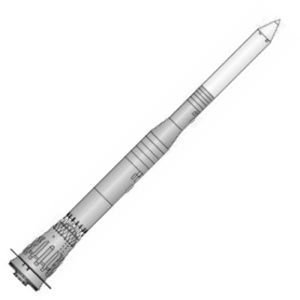
N-IFV-II, III
N-IFV-II, III of 1965
Feeling he had Khrushchev's support, Korolev on 25 May 1964 drafted a letter to Brezhnev, then in charge of missile development. Korolev complained of the delays in the N-I due to lack of priority and financing. He noted that of 11 million rubles budgeted for construction of the launch complex in1964, only 7 million had been received. Two years after authorization ,work on the guidance systems had not even begun, due to the priority of military projects. Korolev tried to put the screws to Brezhnev by noting that Khrushchev had always sponsored scientific projects, and that with the Saturn I rocket the Americans had already surpassed the Americans in the booster race. He also attempted to sabotage Chelomei's LK-1 circumlunar project yet again, by noting that he was wasting his time with Glushko's 'low energy' propellants and that a single launch of his N-II could put a Soyuz modification on the same mission.
It is not clear if this letter was sent; and if so, it certainly hurt Korolev with Brezhnev when he would ascend to power in a year's time. But he had convinced Khrushchev of the necessity for a high priority lunar landing project to beat the Americans.
The Lunar Landing Mission and the N-I Upgraded
On 3 August 1964 Command number 655-268 issued by Central Committee of Communist Party for the first time set the objective for OKB-1 to put one man on the moon and return him safely to earth - ahead of the Americans (who had begun over three years earlier, in April 1961). To achieve this aim a large part of the industry had to be mobilized (though not the competing and dissenting Glushko, Yangel and Chelomei enterprises). This would require design of what was designated the L3 complex, with the combined launch vehicle/spacecraft termed the N1-L3. The L3 would utilize the same lunar orbit rendezvous method to achieve moon landing as was selected for the Apollo program. By upgrading the N1 from a 75 metric ton to a 95 metric ton payload capacity it was felt possible that a single N1 launch could accomplish the mission. The L3 complex itself, with a total mass of 95 metric tons, would consist of a fourth stage (Block G) for the N1 to take the L3 from low earth orbit to trans-lunar trajectory; a lunar orbiter with a Soyuz re-entry capsule for return to earth (LOK); a lunar lander (LK) for the landing of a single cosmonaut on the surface of the moon; and a deceleration stage (Block D) which would brake the L3 complex into lunar orbit and then take the LK lander to near zero velocity above the surface of the moon.
The N1-L3 complex was designed not just for a quick initial moon landing, but also for exploration of the moon and near-lunar space for both scientific and military purposes.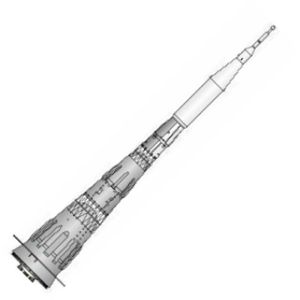
N-IF - 1965
N-IF - 1965 design
In what was only to be the first stage of a sustained campaign, single cosmonauts would land on the lunar surface. However this would be just part of a larger mission with the following objectives:To measure the physical characteristics of near-lunar space and the lunar surface.
To place in orbit around the moon and on the surface high precision automatic and manually-operated scientific equipment.
To solve the navigation and biological problems associated with regular travel along the Earth-Moon trace;
To conduct detailed photo-reconnaissance of the lunar surface from lunar orbit.
To conduct research and determine the most effective means for exploiting the moon for military purposes.
The lunar expedition would utilize the lunar-orbit rendezvous method for reaching the surface. In this way the mission could be accomplished in just one launch of an improved N1. The lunar flight plan was as follows:The L3 complex would be injected into a 220 km, 51.8 degree inclination parking orbit of the earth. Up to one day could be spent in earth orbit before trans-lunar injection.
The Block G stage burned to propellant depletion, putting the complex into translunar trajectory. The Block G then separated.
During a 3.5 day translunar coast the Block D stage would perform two mid-course corrections. It then would put the LOK/LK/Block D stack into an equatorial elliptical lunar orbit. The Block D would be restarted twice to adjust the orbit, first to a circular 110 km orbit, then to bring the pericynthion down to 14 km. The Block D could restarted for up to 4 days in lunar orbit.
The LK pilot-cosmonaut would spacewalk from the LOK to the LK and check out the lander and Block D systems.
The LK/Block D then separated from the LOK. As it approached the landing site, the Block D then began its main burn and braked the LK to 100 m/s at four kilometers above the lunar surface. The Block D then separated and crashed on the moon.
The LK ignited its engines and hovered to a precision piloted soft landing on the surface.
The LK cosmonaut would exit the LK to the lunar surface. From six to 24 hours would be spent on the lunar surface.
The LK Lunar Cabin and Block E ascent stage launched itself from the LK landing gear (LPU) into lunar orbit. It rendezvoused with the LOK and docked using the 'Kontakt' docking system. The LK cosmonaut spacewalked from the LK back to the LOK with the lunar samples. The LK was then cast off.
After up to one additional day in lunar orbit, the LOK's Block I engine would put the LOK into trans-earth trajectory. 3.5 days was to be spent on the coast back to earth with two midcourse corrections en route.
Before re-entry, the descent module separated from the LOK with the two cosmonauts aboard. It re-entered the earth's atmosphere over the South Pole at 11 km/sec, skipped back out to space after slowing down to 7.5 km/s, then soared 5,000 km before making final re-entry and landing on the territory of the USSR.
Total mission time was to be 11 to 12 days.
The work for the L3 project was split as follows:OKB-1 (Korolev): General management, design of Blocks G and D, design of the engines for Block D, L, and LOK.
OKB-276 (N. D. Kuznetsov) - engines for Block G
OKB-586 (Yangel) - the LK lunar lander and the engines for the lander Block E rocket stage
OKB-2 (Isayev) - the complete propulsion system (tanks, controls, engines) for the LOK lunar orbiter Block I stage.
NII-94 (V. I. Kuznetsov) - guidance systems for the L3 (LOK/LK/Block D) lunar complex
NII-AP (Pilyugin) - guidance systems for the LOK
NII-885 (Ryazanskiy) - radio telemetry systems
GSKB Spetsmash (Barmin) - N1 launch complex and N1/L3 ground systems
Saturn Factory (Lyulka OKB) - 40 metric ton thrust engines for the Blocks G and V. They would also work with OKB-1 in design for the 8.5 metric ton thrust Block D engine, derived from the third stage engine developed for Korolev's GR-1/8K713 FOBS missile.
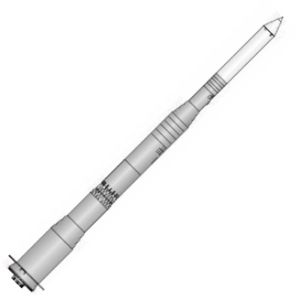
N-IMV-II,III
The plan was for the first launch of the N1 to be in the first quarter of 1966, with the first lunar landings in 1967 to 1968, ahead of the American goal of 1969.
The original N1 with its payload of 75 metric tons to a 300 km, 65 degree inclination orbit would require two to three launches to assemble a lunar landing expedition in earth orbit. One result of the draft project was the decision to increase the N1 payload to 95 metric tons to allow the L3 to be launched toward the moon in one launch. The following measures would increase the N1 payload to 91.5 metric tons:reduction of the altitude of the earth parking orbit from 300 km to 220 km
an increase of the propellant mass of the first stage by 25% (350 metric tons) by supercooling the propellants prior to loading in the launch vehicle (the kerosene to be at -15 to -20 degrees Centigrade, the liquid oxygen at -191 degrees Centigrade)
addition of six engines to the first stage
an increase in thrust of all the engines on the first, second, and third stages by 2%
Then the following measures would increase the payload to 95 metric tons:Replace the steel helium pressurization tanks with plastic tanks
Reduce the parking orbit inclination from 65 degrees to 51.8 degrees
Reduce the telemetry equipment in operational vehicles
The 3 August 1964 decree foresaw completion of manufacture of the N1-L3 to the following schedule: 4 in 1966; 6 in 1967; and 6 in 1968. By September 1964 construction began of the first N1 launch pad (LC110R). Then on October 13, while Voskhod 1 was in orbit, Khrushchev was removed from power and Brezhnev's faction assumed control of Politburo. This immediately led to a shift of political forces. Chelomei lost his main patron and Korolev immediately again attempted to gain control of the L1 manned circumlunar project. Many of Chelomei's pet projects, such as the R Raketoplan, the K Kosmoplans, and their UR-200 booster, were cancelled.
Meanwhile the advance design project for the N1-L3 was completed in collaboration with Kuznetsov's OKB-586 on 30 December 1964. The decree for production of 16 shipsets of spacecraft and boosters was issued on 26 January 1965. After several skirmishes during the year, on 25 October 1965 the Chelomei circumlunar project was given to Korolev and Chelomei's LK-1 manned capsule was cancelled. The new scenario would use a stripped version of Korolev's Soyuz atop Chelomei's UR-500 Proton launch vehicle. While a victory for Korolev, it was an added project at a time that the N1-L3 was in serious technical and schedule problems. Korolev had begun to admit to his colleagues that the moon landing could not come until 1969 at the earliest. He also noted that while development of the Soyuz was proceeding on schedule, Chelomei's LK-1 was badly lagging behind (although the Proton booster was on schedule).
On 25 August 1965 a knock-down-drag-out meeting was held between Ustinov and the Chief Designers. Although he was a received as much criticism as he gave, Korolev's hand in engineering the meeting to wrest control of the LK-1 from Chelomei can be seen. Ustinov contracted the mounting successes of the American space projects with the continuing delays and failures of the Soviet projects. The problems were clearly gross underfunding of the entire program and duplication of effort between the Chief Designers. The Chief Designers fought bitterly and would not back down. But it was clear finally to the leadership that some drastic reorganisation was required to keep up in the space race. Korolev could see that he would soon have the whole thing under his control at last.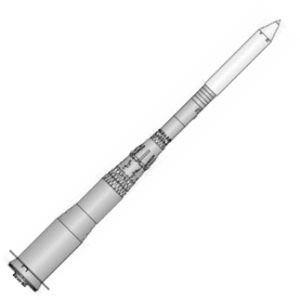
N-IMV-III
Advanced Versions of the N1 - 1965
After completing production drawing release, Korolev's design teams could consider future improved variants of the N1. On November 9, 1965 a four volume study was issued covering these variants. These were:N-IU would be the initial production version of the N1 following the mad rush to make the lunar landings. It would have essentially the same payload but would be substantially re-engineered for sharply improved reliability, most notably with autonomously operating engines. It is interesting to note that four years before the disastrous first flight Korolev already foresaw the potential engine problems that would be the downfall of the project.
N-IF would be the first follow-on version with increased performance. The first stage engines would be increased in thrust from an average of 150 metric tons to 175 metric tons, and those in the second stage from 150 metric tons to 200 metric tons. The second and third stages would be substantially enlarged.
N-IM would mark an tremendous increase in vehicle size and was the ultimate pure liquid oxygen/kerosene version considered. The first stage engines would be increased to 250 metric tons thrust, without reducing reliability, through use of higher engine chamber pressure. Propellant load in the first stage would be almost doubled. Second stage engine thrust would increase to 280 metric tons each and the second and third stages again enlarged.
N-IUV-III would replace the N-IU's conventional third stage with a LOX/LH2 cryogenic third stage. This was seen at the time as the first step in exploitation of cryogenic technology in Russia. Although pursued for some time, this large stage never went into development. The more modestly-sized Block R, Block S, and Block SR instead were put into development in the early 1970's.
N-IFV-III would add the Block V-III cryogenic third stage to the first and second stages of the N-IF.
N-IM-III would add the Block V-III cryogenic third stage to the first and second stages of the N-IM. This provided the second-highest performance of the variations considered and would certainly have been cheaper than the N-IFV-II, III.
N-IFV-II, III would use only the first stage from the N-1F, and use new cryogenic second and third stages. This cryogenic second stage seems not to have been pursued beyond the study phase.
N-IMV-II, III was the ultimate conventionally-powered N1 ever considered. It paired the monster N-1M first stage with new cryogenic second and third stages. Both lift-off thrust and payload of this vehicle would have been double that of the American Saturn V.
At this critical juncture Korolev learned that he was terminally ill with cancer of the colon.
The Death of Korolev - the Race to the Moon - Advanced Upper Stages - 1966 to 1969
N-IUV-III
On January 14, 1966 Korolev died in Moscow during colon surgery. He had kept his illness a secret from his colleagues and his death at 56 came as a surprise to many. This is often cited as a blow from which the project never recovered. His successor, Mishin, did not have the forceful personality and political connections of the original Chief Designer. Korolev also had a legendary ability to motivate his staff and cajole co-operative design bureaus to prioritize work for OKB-1 that Mishin was never able to duplicate.
The project continued. In February 1966 construction started of the second N1 launch pad (LC 110L). By November the first N1 hardware arrived at Baikonur and construction of the 1M1 full-size mock-up of the launch vehicle began. On 16 November 1966 another Keldysh-headed expert commission considered the state of the program. With Korolev dead, once again Glushko, Chelomei, and Yangel advocated development of the UR-700 or R-56 in lieu of the N1. While it was agreed that engine development and studies of these launch vehicles could continue, the government decree issued approved Mishin's draft plan for the first lunar landing. The first N1 launch was now to be in March 1968 (two years late to the very optimistic schedule set when the project was first full approved).
UR-700
UR-700 lunar landing launch vehicle - cutaway showing arrangement of N2O4 oxidiser tanks (green) and UDMH fuel tanks (orange). The outer nine 4.1 m diameter modules contained fuel and oxidizer tanks for stage 1 and fuel tanks for the three core modules. After propellant depletion, the nine outer modules would separate, leaving the three core modules to continue their burn. The third stage, based on the Proton first stage, placed the LK-700 spacecraft into a 200 km earth orbit. The LK-700 was equipped with four nearly identical clustered stages. The three outer stages fired to place the spacecraft on a translunar trajectory. The inner core stage was used for midcourse corrections, braked the spacecraft into lunar orbit, and then again until it was just above the lunar surface.
Credit: © Mark Wade
However now the schedule seemed to be holding and in February 1967 the government approved integrated L1/L3 project plans indicating a landing on the moon by the end of 1968 - still ahead of the Americans. The N1 test plan envisioned third quarter 1967 as the beginning of flight hardware construction. First manned L1 circumlunar mission using the Proton booster was anticipated as early as June 1967. The first N1 launch was still set for March 1968. A moon landing would not come until the third quarter of 1969 at the earliest.
In February assembly of the first N1 began at the Progress plant in Samara. On March 10 1967 Cosmos 146 was launched in the first test of hardware (the Block D stage and L1 lunar spacecraft) to be used in the L1 and L3 projects. The boilerplate Soyuz 7K-L1 was launched by a Proton into the planned highly elliptical earth orbit. The Block D stage functioned correctly in its first test, putting the spacecraft into a translunar trajectory. The spacecraft was not aimed at the moon and no recovery was planned or attempted. This successful launch created a false confidence just before the string of failures that would follow. On April 8 Cosmos 154 reached earth orbit but the Block D translunar injection stage failed to fire (ullage rockets, which had to fire to settle propellants in tanks before main engine fired, were jettisoned prematurely). The spacecraft burned up two days later when its orbit decayed.
N1 Flight Test Begins - 1968-1969
By the end of summer the first N1 launch pad (LC110R) was completed. In addition to the sixteen flight vehicles, two N1 mock-ups were being built to support pad compatibility tests. Assembly of the first 1M1 mock-up was nearing completion at the MIK assembly building at Baikonur. In September 1967 the EU-28and EU-29 test models of the second and third stages began hot firing tests on their test stands at Samara. On 25 November 1967 the 1M1 mock-up was first erected on LC-110R. After tests of electrical and hydraulic interfaces on the pad it was returned to the assembly building on 12 December.
A decree in November had recognized yet further slips in the schedule, with a first flight test of the vehicle not expected until the third quarter 1968. By March 1968 it was recognized that no Soviet manned lunar landing would take place until 1970. On May 7, 1968, eight months behind the 1966 schedule, N1 booster 4L was erected at launch complex 110R. Under its shroud was the 7K-L1S spacecraft. This modification of the 7K-L1 circumlunar Soyuz incorporated the Isayev forward propulsion module that would be used on the LOK and LK. A mass model representative of the LK lander was also included. These early test N1's were limited to a lift-off mass of 2,735 metric tons and had an earth orbit payload of 70 metric tons. Even so it has taken 165 train wagon-loads of material to construct the vehicle, as against the 43 estimated in the 1962 draft project.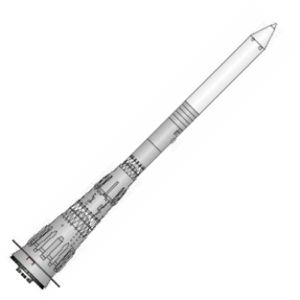
N1FV-III
N-IFV-III design of 1965
A September 1968 flight test was planned. However the first stage oxidizer tank developed cracks during ground tests, and 4L was removed from the pad in June 1968. The first stage was cannibalized; the upper stages were incorporated into the 1M1 mock-up for further training of the launch crews. While the next N1, 3L, was being completed, this modified 1M1 was moved back to the pad for further ground tests and launch crew training. It remained there until the end of September.
Returned to the MIK, the flight payload taken from 4L, the 7K-L1S, was integrated with the 1M1. The 1M1-L1S was moved back to the pad in November to conduct tests of the payload. It was joined by 3L, erected on launch pad without its payload (which was on the 1M1 mock-up). This was the first, but not the last, dual N1 roll-out. 3L was put through a series of engine system tests. In January 3L was returned to the MIK and the L1S payload was integrated to the launch vehicle. Also under the L3 payload shroud was an LZS functional test model of the LK.
The first 28 day long N1 countdown began in January with the roll-out of 3L to the pad. Mishin personally led 2,300 technicians in around-the-clock shifts to prepare the vehicle for its first flight. Fifty tanker cars of propellants were required to fuel the booster. The initial planned launch on February 20 was scrubbed because of weather. Finally, on February 21, 1969, N1 serial number 3L rose into the sky, thundering over the roofs of the assembly worker's apartments as they cheered it on. But trouble was afoot. Small metallic particles lodged in the gas generator turbine of engine 2. This resulted in a rising high frequency oscillation, eventually causing some engine components to fatigue and tear off their mounts. A forced leak of propellants followed, setting in motion a fire in the tail compartment. The KORD's BKS engine monitoring system detected the fire, but then gave an incorrect signal shutting down all engines at 68.7 seconds into the flight. The vehicle was destroyed by range safety 1.3 seconds later. The SAS escape tower worked as designed and the 7K-L1S capsule was recovered. The main body of the rocket impacted 45 km downrange from the launch pad. British intelligence detected the launch attempt, but the CIA's technical means for some reason missed it and they denied for years that it had ever occurred.
The failure of the KORD was attributed to the much higher than expected temperatures in the engine compartment. The next vehicle, 5L, was modified by having the KORD moved to the intertank compartment. Additionally, ventilation openings to the engine compartment were introduced below the fuel line fairings.
Against this failure, the Apollo program was achieving success after success in bimonthly missions. While beating the Americans to a moon landing was now clearly impossible, a dual unmanned mission was devised, which, if successful, would have stolen a little of the American's thunder. The plan was for the next N1 to launch an unmanned 7K-L1S spacecraft on a loop around the moon. It would take multi-spectral photographs of the lunar surface and far side. Meanwhile, a Proton rocket would launch an unmanned Ye-8 soil return spacecraft. This would soft land on the moon, deploy a core drill which would take a small sample of lunar regolith. Deposited in a small spherical re-entry capsule, this then would automatically be returned to earth.
Cutaway of N1
Credit: RKK Energia
The unremitting three-shift work continued. To meet the schedule the modifications to 5L had to be made according to engineering sketches and red-lined drawings. Changes were verified on the 1M1 mock-up before metal was cut on the 5L. The modified vehicle 5L was finally launched on July 3 1969, just two weeks before the Apollo 11 first moon landing mission. It was a catastrophe. 5L already began to fail at 0.25 second after lift-off when the oxidizer pump of engine number 8 ingested a slag fragment and exploded. A fire ensued as the vehicle climbed past the top of the tower. The KORD reacted and engines were shut down in pairs until the acceleration dropped below 1 G; then the vehicle began to fall back to the pad at a 45 degree angle. The escape tower fired at the top of the brief trajectory, taking the L1S descent module away from the pad. Upon impact of the base of the N1 with the pad, the vehicle exploded with the force of a small nuclear bomb, destroying launch complex 110R. US weather and meteorological satellites revealed the disaster to the US intelligence agencies, and word soon spread through the government.
The investigation of this failure would result in substantial modifications to the N1 and it would be two years until the next launch attempt. The accident investigation commission came to three main conclusions: the engines must be redesigned with filters to prevent ingestion of metal splinters and shavings into the turbine machinery; the KORD logic must be modified to prevent unnecessary shut down of engines; and the launch vehicle trajectory had to be modified so that it moved away from the pad as soon as it cleared the tower.
With the moon race lost, the rationale for further development of the limited 7K-LOK and LK spacecraft for a dash to the moon disappeared. The LK would be test flown in the coming years, but the LOK never was. Mishin instead looked towards using the N1 to establish a moon base (LEK - Lunar Expeditionary Complex).
Redesign and New Missions - 1969 to 1974
The three-year job of rebuilding Pad 110R began on August 3, 1969. By September 24 an N1 was erected on launch pad 110L to test the launch pad interfaces. This all-white launch vehicle, with no payload, was either the N1 mock-up 1M1 or flight vehicle 6L. This was the first use of the all-white paint job - the previous grey and white scheme had resulted in summer temperatures of up to 60 degrees Centigrade in the intertank compartments.
It was not until May 18 of 1970 that US reconnaissance satellites detected another N1 being installed on the pad. Again with no payload, it remained there at least through 4 June.
Against these failures, development was already underway to develop more powerful versions of the N1 to launch heavier payloads to the moon. The N1 growth study S. P. Korolev had signed shortly before his death had foreseen the wide use of oxygen-hydrogen propellants in modified versions of the N1 launch vehicle.
It will be recalled that the 1965 study foresaw development of a Block V-II Lox/LH2 replacement for the Block B second stage of the N1. At OKB-276 N. D. Kuznetsov led a project to develop a liquid oxygen/liquid hydrogen version of the NK-15V engine with a flight thrust of 200 metric tons for use in this modernized version of the second stage of the N1. However Kuznetsov was having enough difficulty in completing satisfactory development of the conventional version of this engine for use in the basic N1 and his 200 metric ton engine did not reach the hot firing test stage.
N1F - Sr
N1F with Sr Lox/LH2 upper stage
While these more ambitious plans would not be realized, the collectives OKB-2 (A. M. Isayev) and OKB-165 (A. M. Lyulka) were continuing studies and basic development that had begun in 1961. The first Russian use of hydrogen as a fuel was planned for rocket stages of relatively small size (with up to 50 metric tons of fuel). These stages, which were designated Block S and Block R, were to be introduced in place of N1 Blocks G and D as part of a modernized L3M lunar spacecraft complex. Use of oxygen-hydrogen propellants would permit expeditions to the moon of three crew, of which two would walk on the surface of the moon.
Isayev set about adapting the 11D56 engine, with a vacuum thrust of 7.5 metric tons, for the Block R. This engine had originally been designed in the early 1960's for use in the third stage of an uprated Molniya-L launch vehicle. The new Block R for the N1 was to have an empty mass of 4.3 metric tons, a maximum fuel load of 18.7 metric tons, and would have been 8.7 m long and 4.1 m in diameter.
Lyulka developed two variants of a 40 metric ton engine - the 11D54 (with fixed chamber) and 11D57 (with gimballed chamber). These would be used for the new Block V-III third stage of the N1 (3 to 6 11D54) and in the Block S (one 11D57).
First hot firings of the 11D56 on the test stand began in June 1967. Both the 11D56 and 11D57 engines successfully completed their state development test series.
At the Tsniimash museum in Korolev a photograph is displayed of a dynamic test model of an N1 configuration that has been called N1M. This model shows an N1 first stage, with a Block V-III second stage, and Blocks S and R third and fourth stages. Calculations indicate that a two stage Block A / Block V-III N1 would have a low earth orbit payload comparable to that of the basic N1 (around 95 metric tons). Evidently this configuration was considered as an alternative to a conventional three stage N1 for launching the L3M complex into low earth orbit.
The original draft project for the new N1M-L3M lunar landing complex anticipated use of a two-launch profile. On the first launch a Block R RTB braking stage would be put on a translunar trajectory. The RTB would place itself in lunar orbit. Next, the manned L3M lunar lander would be launched. This new spacecraft was much larger than the LK, with a mass of 21 metric tons landed on the lunar surface. The L3M would dock, tail-first, with the RTB stage in lunar orbit. The RTB would act as a lunar crasher stage. The L3M would separate from the RTB just over the lunar surface, then hover to a soft landing. The crew would spend up 16 days on the surface. Following completion of their work, the landing legs would be left behind, and the L3M would launch itself on a trans-earth trajectory. Just before arrival at earth, the crew would enter their Soyuz capsule, separate from the L3M, and make a lifting re-entry into the earth's atmosphere. It was felt that within the existing funding allocation of the original N1-L3 program, enough N1's would be available to support a series of landings in 1978-1980.
N1M 1974
N1M of 1974
In July 1970 Kuznetsov was given authorization to design substantially improved versions of the N1 rocket engines. These would include filters in the propellant lines to prevent ingestion of debris in the turbo-machinery; improved vibration isolation; autonomous operation; and many detailed reliability and durability improvements. So substantial were the changes that they received a completely new series of designations (NK-33, NK-43, NK-39, NK-31 in place of NK-15, NK-15V, NK-19, NK-9V). However it would take over three years of design, development, and test before these new engines would be available.
The N1 that would utilize these engines was designated the N1F (this had no relation to the much more powerful N1F design of 1965 - it was more like the N1U 'perfected' N1 design of the same year). With a payload to a 225 km orbit of 105,000 kg, the N1F would use the new engines, higher density superchilled propellants in all stages, lighter stage structures and numerous detailed changes. Following extensive wind tunnel studies, the boat tail was again redesigned in detail to cope with gas dynamics problems. A cylindrical base reduced the vehicle maximum diameter from 16.9 m to 15.8 m. Four high-thrust roll 'steering' engines were later added to prevent the loss of control that would destroy the 6L launch vehicle. The KORD was completely redesigned, a fire extinguishing system was installed, improved isolation of cabling and electronics was introduced. The telemetry system was reduced in weight while increasing the number of points measured from 700 to 13,000.
Full go-ahead to develop a liquid hydrogen/liquid oxygen high energy upper stage for the N1F finally came in June 1970. The decision was made to develop a multi-engine Block Sr with a propellant mass of 66.4 metric tons. This single stage would be used in place of the previously-planned Blocks S and R to insert spacecraft of the Lunar Expeditionary Complex (LEK) into low lunar orbit. It was also to be used to insert heavy spacecraft into geosynchronous orbit and on interplanetary trajectories. The increased payload of the N1F, combined with the Block Sr stage, would allow a single N1F launch to place 27 metric ton spacecraft on the lunar surface. The L3M lander could be increased in capability to allow three month stays on surface.
It was decided to incrementally test the planned changes for the N1F lower stages, but using the old engines. Vehicle 6L was substantially improved, incorporating filters in the propellant lines to prevent any foreign objects from getting into the pumps.. The shape of the tail of the booster was modified, and ventilation and refrigeration systems were added to keep the engine compartment cool. It was rolled out with the all-white paint scheme. A planned June 23, 1971 launch was delayed for three days by heavy rain. On June 27, almost two years after the last attempt, N1 serial number 6L thundered into the sky. After lift-off and ascent, the vehicle made the new evasive maneuver to move away from the pad. The axial rotation this started was aggravated by the by gas dynamics interactions of the thirty engines with the air slipstream. The launch vehicle developed a roll beyond the capability of the control system to compensate. 6L began to break up as it went through Max Q. Control was lost at 50.2 seconds into the flight and it was destroyed by range safety a second later. The main body of the rocket impacted 20 km downrange. However the engines functioned well and did not shut down up to the point of vehicle destruction. No functional payload was carried and this launch did not have a working launch escape system. Although still counted as a failure, the technical difficulties were being solved one-by-one.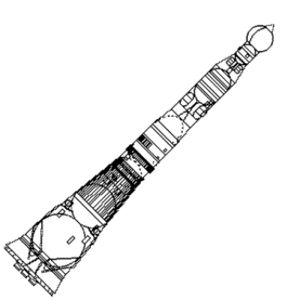
N1M cutaway
Credit: © Mark Wade
Work on advanced payloads for the N1 continued. It may be recalled that the N1 draft project of 1962 spoke of 'establishment of a lunar base and regular traffic between the earth and the moon'. Korolev raised the matter informally at tea with Chief Designer of rocket complexes Vladimir Pavlovich Barmin, head of GSKB SpetsMash (State Union Design Bureau of Special Machine-Building). Barmin was interested in pursuing the subject, but questioned how could such a base be placed on the moon. 'You just design the base', Korolev assured him, 'and I'll figure out how to get it there'. The project was known to SpetsMash as the 'Long-term Lunar Base' (DLB) and to OKB-1 as 'Zvezda'. Consideration was given to using the same elements in expeditions to other planets. Under the DLB studies SpetsMash defined the purposes of the base, the principles of its construction, phases of its deployment and composition of its scientific and support equipment. The enthusiasts that worked on the project at SpetsMash were naturally known as 'lunatics'.
Zvezda would have utilized unmanned spacecraft designed by the Lavochkin OKB to conduct initial reconnaissance of the prospective moon base site. These would use lunar soil core drills to obtain samples of the soil and return them to earth for analysis, and Lunokhod rovers to survey the site. If the site was found to be satisfactory, these craft had radio beacons which would guide follow-on elements of the base to precision landings.
Ambitious articulated mobile nuclear-powered Lunokhod laboratories would take the cosmonauts from the landing sites on long-duration traverses of the lunar surface. The Lunokhods were equipped with core samplers and manipulators so that the crew could conduct collection of surface samples from within the pressurized cab without the need to always exit the ship and conduct surface operations in space suits. One of the main objectives of the base would be the location and mining of Helium-3 for use in nuclear fusion reactors on earth. Rare on the earth, Helium-3 was abundant on the moon, having collected in the regolith from the solar wind.
Barmin's lunar base would be crewed by nine cosmonauts and consist of nine modules. These modules would have a length of 4.5 m during launch and transport on the moon. Once position in place on the surface of the moon and inflated with air, they would telescope out to 8.6 m length with a total floor area of 22.2 square meters. Power would be provided by nuclear reactors.
The nine modules would be pre-equipped in the factory for specialized functions: command module, laboratory/warehouse module, workshop module, midpoint module, medical/gymnasium module, galley module with dining room, and three living modules.
In later versions, the manned elements apparently used the improved L3M complex (designed for the follow-on two man lunar landings) to ferry manned crews from earth orbit to lunar orbit and then from lunar orbit to the surface and back. The Block Sr LOX/LH2 stage would be used to insert the components of Zvezda into low lunar orbit.
By 1971 the lunar city project was practically complete and Chief Designer Barmin arranged a meeting with Secretary Ustinov, head of all military and space rocketry. He brought along two of this 'lunatics', Aleksandr Yegorov and Vladimir Yeliseyev. The project was defended in a marathon meeting - nine presentations over six hours. At the conclusion, Ustinov agreed that the project should go ahead - but he couldn't decide, at the pace of a walk or the speed of a freight train. In the event, the point was moot.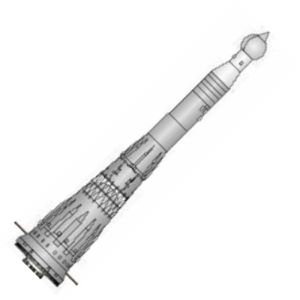
N1M - Sr
In the second half of 1972 and first half of 1973 TsKBEM began technical development of a Multi-module Orbital Complex (MOK). This was an integrated earth orbit infrastructure of space stations, free-flying modules, and massive geostationary satellites. It harked back to Korolev's �Orbital Belt' scheme of a decade earlier. The N1 would be used to launch the two main components of the MKBS Multi-module Cosmic Base Station into a sun synchronous 450 km orbit at 97.5 degrees inclination. The N1/Block Sr combination would be used to place enormous communications platforms into geosynchronous orbit. It was foreseen that in the later stages of the MOK the ultimate derivative of the N1 would provide reusable logistic support to the station. This would be a single-stage-to-orbit modification of the N1 Block A stage using a combination of air-breathing LACE (Liquid Air Cycle Engines) booster engines and liquid hydrogen/oxygen propellant sustainer engines on the core. This ultimate N1 was one of several versions sketched by Soviet engineers for US intelligence operative Peter N James in 1972-1973.
Meanwhile the test flight series continued, albeit at a slow rate. N1 serial number 7L incorporated most of the changes expected for the N1F, except for the new engines, which were still not available. Payload for this mission consisted of a (now obsolete) 7K-LOK lunar orbiter and an LK functional model. The launch of 7L came on November 23 1972. The rocket ascended into the sky, and the engines ran 106.93 seconds, only seven seconds before completion of first stage burnout.
At this point, to reduce the G forces on the vehicle, a programmed shutdown of six engines occurred. Immediately thereafter, the oxidizer pump of engine number 4 exploded. The vehicle was destroyed by range safety before the second stage could separate and begin operation. The root cause was never determined. Mishin blamed the engine designers. Kuznetsov claimed that they were not at fault, saying the shutdown of the central engines had led to propellant line hammering, followed by rupture of propellant lines, resulting in the explosion of engine number 4. All agreed that if the N1 first stage had simply been shut down, and Stage 2 ignited, a successful mission could have followed.
N1 with Aerospike First Stage Engine
While the first N1F vehicle had yet to fly, studies continued on a number of improved N1's. One of these contemplated the use of an aerospike engine in the first stage. Two variants were considered. In the first, the 30 x 151 metric ton thrust NK-15 engines of the first stage were replaced with 24 x NK-15F engines of 188 metric tons thrust. This freed up the center of the stage for a truncated aerospike. As in similar designs advocated by Philip Bono in the United States, hot gas would be bled off from the engines to produce an �aerospike' streaming behind the booster, which would contour the combined rocket exhaust into an optimum flow. The advantage of the aerospike was that it �auto-corrected' for altitude, providing optimum specific impulse over a range of conditions.
The second variant eliminated the NK-15's completely and used a radical annular combustion chamber that surrounded the aerospike. Detailed mass calculations were made for each variant. The final study found that an improvement was achieved - but probably not one that justified the development expense and risk. The empty mass of the stage increased because the central body of the aerospike and the exhaust gas system were all additional features. Further, the NK-15's were closed cycle engines. Bleeding hot gas from them for the aerospike actually reduced their inherent specific impulse.
N1F - 1974
N1F - 1974 Configuration (N1 s/n 8L)
For Variant A, a substantial development program would be required to increase the NK-15's thrust by 24%. Variant B required an even bigger program, and learning how to vector the thrust of the annular engine (by diverting even more hot gas from the engines) for rocket steering would take a lot of flight test experience.
The final conclusion of the study was that the improvement in performance was not worth the development risk in three-stage, low specific impulse designs such as the basic N-1. Using the �standard' N1 second and third stages, payload was increased only 5.0% for Variant A and 6.9% for Variant B. It was concluded that the aerospike could provide bigger performance gains in single- or two- stage-to-orbit designs or in upper stages.
The final design comparison was as follows:
References
* Przybilski, Olaf, and Wotzlaw, Stefan, N-1 Herkules - Entwicklung und Absturz einer Traegerrakete, Schriftenreihe der Deutschen Raumfahrtausstellung e.V., 1996.
* Rusakov, K, "'Aerospaik' dlya N-1", Novosti kosmonavtiki, Number 7, 1998, p. 27.
* Semenov, Yu. P., Raketno-Kosmicheskaya Korporatsiya ENERGIYA imeni S. P. Koroleva 1946-1996, RKK Energia, 1994.
* Vetrov, G S, S. P. Korolev i evo delo, Nauka, Moscow, 1998.
Subtopics
| N-1 11A52 The N1 launch vehicle as flown. These test vehicles did not exceed 2735 metric tons liftoff mass and 70 metric ton earth orbit payload capability. Four flight tests, all failures. |
|---|
| N1 1962 Russian heavy-lift orbital launch vehicle. Final configuration of the N1 at the time of development go-ahead in 1962. The 75 metric ton payload was to consist of the Raskat dispenser, which would have delivered 17 multi-megaton nuclear warheads, essentially destroying the United States in a single launch. The design also supported the OS-1 heavy space station and TMK manned Mars flyby requirements - as opposed to any manned lunar landing project. |
|---|
| N1 1964 Russian heavy-lift orbital launch vehicle. The N1 launch vehicle for the N1-L3 lunar landing mission as described in the draft project of 1964. Design requirement for the single-launch lunar-orbit-rendezvous lunar landing was 2750 metric tons liftoff mass and 95 metric tons low earth orbit payload. The actual N1 that flew in 1969 to 1972 had lighter first and third stages, but never demonstrated a full fuel load using superchilled propellants as planned in the draft project. |
|---|
| N1 1969 Russian heavy-lift orbital launch vehicle. The N1 launch vehicle, developed by Russia in the 1960's, was to be the Soviet Union's counterpart to the Saturn V. The largest of a family of launch vehicles that were to replace the ICBM-derived launchers then in use, the N series was to launch Soviet cosmonauts to the moon, Mars, and huge space stations into orbit. In comparison to Saturn, the project was started late, starved of funds and priority, and dogged by political and technical struggles between the chief designers Korolev, Glushko, and Chelomei. The end result was four launch failures and cancellation of the project five years after Apollo landed on the moon. Not only did a Soviet cosmonaut never land on the moon, but the Soviet Union even denied that the huge project ever existed. |
|---|
| N1 Nuclear A Russian nuclear orbital launch vehicle. A version of the N1 with a nuclear upper stage was studied by Korolev in 1963. It was concluded that the optimum design would allow a single N1 to launch a direct manned lunar landing and return. However for manned Mars missions, a nuclear electric engine was found to be much more efficient. This essentially killed further consideration of thermal nuclear upper stages within the bureau. |
|---|
| N1 Nuclear AF Russian nuclear orbital launch vehicle. A variant of the first alternative considered in the 1963 nuclear N1 study. This was a 'high thrust' version of the Type A engine - apparently with higher propellant rate, lower specific impulse, and lower engine weight. Due to the very low density of the enormous liquid hydrogen upper stages, these immense vehicles would have been very ungainly (and had interesting stress problems during ascent!) |
|---|
| N1 Nuclear V Russian nuclear orbital launch vehicle. Second primary alternative considered for the 1963 nuclear N1 study. The immense liquid hydrogen tank of the second nuclear stage would have dwarfed the N1 first stage mounted below it in the shadows. The extremely poor thrust to weight ratio of the Type V engine design compared to that of the Type A remains unexplained. |
|---|
| N1 Nuclear V-B Russian nuclear orbital launch vehicle. N1 with nuclear upper stage. This variant of the Type V nuclear engine used a very heavy radiation shield to protect the crew of any manned spacecraft payload. |
|---|
| N11 Russian heavy-lift orbital launch vehicle. It was originally planned the N1 would form the basis of a family of launch vehicles that could replace existing ICBM-derived boosters. The N11 would use the second, third, and fourth stages of the N1. This would give it a lift-off mass of 700 metric tons and a 20 metric ton payload into low earth orbit. It could replace Chelomei's Proton launch vehicle in the medium-lift role. |
|---|
| N11 1963 Russian heavy-lift orbital launch vehicle. A military variant of the N-11 which would use a powerful third stage, probably derived from the first stage of the 8K713 GR-1, to put up to 24 metric tons in low earth orbit. This was a competitor with Chelomei's UR-500K, which was selected instead for the heavy military payload mission. |
|---|
| N111 Russian heavy-lift orbital launch vehicle. It was originally planned the N1 would form the basis of a family of launch vehicles that could replace existing ICBM-derived boosters. The N111 would use the third and fourth stages of the N1, and the second stage of Korolev's R-9 ICBM. This would result in a lift-off mass of 200 metric tons and a five metric ton payload. It could replace the R-7 derived boosters (Vostok and Soyuz) in this payload category. |
|---|
| N11GR Russian orbital missile. This 1962 project was designed by Korolev's OKB as a competitor to Chelomei's UR-500 against the military GR-2 (Global Rocket 2) requirement. The N-11GR was an adaptation of the basic N-11, derived from the second and third stages of the N1 heavy booster. The GR-2 was to be a kind of enormous multiple-warhead FOBS (fractional orbit bombing system). Surrounding the top of the second stage of the rocket, like bullets in an enormous revolver, were six final stages derived from the 8K713 GR-1 last stage. Each stage had a 1,500 kg nuclear warhead. |
|---|
| N1F Russian heavy-lift orbital launch vehicle. The N1F would have been the definitive flight version of the N1, incorporating all changes resulting from the four flight tests of the vehicle, including the new Kuznetsov engines and 10% greater liftoff mass by using superchilled propellants in all stages. N1 8L would have been the first N1F configuration flight, with launch planned in the third quarter of 1975 at the time the project was cancelled. |
|---|
| N1F Sr Russian heavy-lift orbital launch vehicle. The final more modest version of the N1F replaced the fourth and fifth stages of the N1 with the single liquid oxygen/liquid hydrogen Block Sr stage. Development of the Sr stage was from May 1971 until cancellation of the N1 project in May 1974. |
|---|
| N1F-L3M Russian heavy-lift orbital launch vehicle. The N1M was found to be too ambitious. The N1F of 1968 was instead penciled in to be the first Soviet launch vehicle to use liquid oxygen/liquid hydrogen high energy cryogenic propellants. The N1F would have only used the Block S and Block R fourth and fifth stages in place of the N1's Block G and Block D. |
|---|
| N1M Russian heavy-lift orbital launch vehicle. The N1M was to be the first Soviet launch vehicle to use liquid oxygen/liquid hydrogen high energy cryogenic propellants. It was designed to launch payloads in support of the LEK lunar expeditions (two cosmonauts on the surface), the DLB (long-duration lunar base), and heavy unmanned satellites into geosynchronous and interplanetary trajectories. As originally conceived, the advanced propellants would be used in all upper stages. However due to delays in Kuznetsov development of a 200 metric ton thrust LOx/LH2 engine, the final version used an N1 first stage, with a Block V-III second stage, and Blocks S and R third and fourth stages. |
|---|
| N1-MOK Russian heavy-lift orbital launch vehicle. Ultimate derivative of N1. Single-stage-to-orbit vehicle based on N1 Block A. Propellants changed to LH2/LOX, 16 x modified NK-33 engines + 4 Liquid Air Cycle Engine Liquid Air/LH2 boosters. All figures estimated based on tank volume of Block A and delivery of 90,000 kg payload to 450 km / 97.5 degree MKBS orbit. Briefly described in RKK Energia official history and in some detail in Peter James' 1974 book Soviet Conquest from Space! |
|---|
| N-IF 1965 Russian heavy-lift orbital launch vehicle. The N-IF would be the first follow-on version with increased performance. The first stage engines would be increased in thrust from an average of 150 metric tons to 175 metric tons, and those in the second stage from 150 metric tons to 200 metric tons. The second and third stages would be substantially enlarged. |
|---|
| N-IFV-III Russian heavy-lift orbital launch vehicle. Then N-IFV-III would add the Block V-III cryogenic third stage to the first and second stages of the N-IF. |
|---|
| N-IFV-II-III Russian heavy-lift orbital launch vehicle. N-IFV-II, III would use only the first stage from the N-1F, and use new cryogenic second and third stages. This cryogenic second stage seems not to have been pursued beyond the study phase. |
|---|
| N-IM 1965 Russian heavy-lift orbital launch vehicle. The N-IM would mark an tremendous increase in vehicle size and was the ultimate pure liquid oxygen/kerosene version considered. The first stage engines would be increased to 250 metric tons thrust, without reducing reliability, through use of higher engine chamber pressure. Propellant load in the first stage would be almost doubled. Second stage engine thrust would increase to 280 metric tons each and the second and third stages again enlarged. |
|---|
| N-IMV-III Russian heavy-lift orbital launch vehicle. Then N-IMV-III would add the Block V-III cryogenic third stage to the first and second stages of the N-IM. This provided the second-highest performance of the variations considered and would certainly have been cheaper than the N-IFV-II, III. |
|---|
| N-IMV-II-III Russian heavy-lift orbital launch vehicle. N-IMV-II, III was the ultimate conventionally-powered N1 ever considered. It paired the monster N-1M first stage with new cryogenic second and third stages. Both liftoff thrust and payload of this vehicle would have been double that of the American Saturn V. |
|---|
| N-IU Russian heavy-lift orbital launch vehicle. The N-IU would be the initial production version of the N1 following the mad rush to make the lunar landings. It would have essentially the same payload but would be substantially re-engineered for sharply improved reliability, most notably with autonomously operating engines. It is interesting to note that four years before the disastrous first flight Korolev already foresaw the potential engine problems that would be the downfall of the project. |
|---|
| N-IUV-III Russian heavy-lift orbital launch vehicle. The N-IUV-III would replace the N-IU's conventional third stage with a LOX/LH2 cryogenic third stage. This was seen at the time as the first step in exploitation of cryogenic technology in Russia. Although pursued for some time, this large stage never went into development. The more modestly-sized Block R, Block S, and Block SR instead were put into development in the early 1970's. |
|---|
| Superraket Russian nuclear orbital launch vehicle. The ancestor of the N1 lunar launch vehicle, this was the first heavy lift launch vehicle actively considered in the USSR. The 2,000 metric ton liftoff mass was similar to the later N1 design, but the first stage would use a staggering cluster of around 66 Kuznetsov NK-9 engines (as opposed to the modest 24 NK-15's of the first N1 configuration). The real difference was in the second stage, which used the nuclear YaRD engine, giving the launch vehicle nearly double the later N1's payload capacity. |
|---|
| YaKhR-2 Russian nuclear-powered orbital launch vehicle. First large space launcher considered in the Soviet Union. It would have had the same layout as the R-7, but with six strap-ons increased in size by 50%. The core, igniting at altitude, used a nuclear thermal engine using ammonia as propellant. Dropped in favor of development of conventional chemical propulsion. |
|---|
Country: Russia. Engines: NK-19, NK-15V, NK-21, 8D415K, NK-15, RD-54, RD-58. Spacecraft: MPK, TMK-E, TMK-1, Vostok, OS, L1-1960, L4-1960, TKS Heavy Space Station, OS-1962, OP, OS-1 (1965), DLB Module, L3-1963, L4-1963, L5-1963, Global Communications Satellite Using Nuclear Power, Mavr, L3, KK, Soyuz 7K-OK, OS-1 (1969), Soyuz 7K-L1, L5-1967, L3M-1970, DLB Lunar Base, Mars 5NM, Luna Ye-8, Soyuz 7K-L1A, Luna Ye-8-5, MKBS, MEK, OS-1 Lunar, LK, Soyuz 7K-LOK, DLB Lunokhod 1, DLB Lunokhod 2, DLB Lunokhod 3, L3M-1972. Launch Sites: Baikonur, Baikonur LC110R, Baikonur LC110L. Stages: N1 Block G, N1 Block V, N1 Block B, N1 Block A, N1 Block D. Agency: Korolev bureau. Bibliography: 123, 125, 164, 165, 168, 2, 21, 23, 283, 288, 32, 367, 376, 474, 51, 57, 69, 70, 72, 75, 77, 84, 89, 96.
Photo Gallery
 |
N1 Pad ConstructionN1 Pads Under ConstructionCredit: RKK Energia |
|---|
 |
N1 Side ViewCredit: © Mark Wade |
|---|
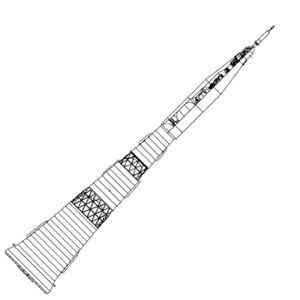 |
N1 LVCredit: © Mark Wade |
|---|
 |
N1 Early DesignEarly design of N1 with aerospike first stageCredit: Gleb Aleksushin |
|---|
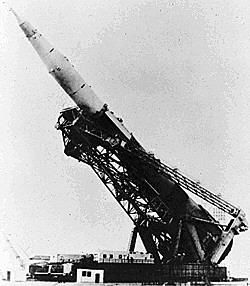 |
Early model of N1Early model of N1 being erected by the Grasshopper carrier. A retouched version of this photo was the first one released to the West.Credit: RKK Energia |
|---|
 |
N1-L3 Payload ShroudCredit: © Mark Wade |
|---|
 |
NK-15 / 11D51NK-15 / 11D51 rocket engine for first stage of N1Credit: © Mark Wade |
|---|
 |
NK15 engineNK-15 / 11D51 rocket engine for first stage of N1Credit: © Mark Wade |
|---|
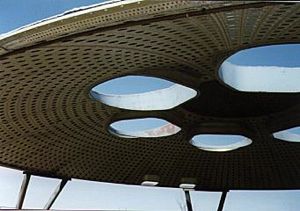 |
N1 base heat shieldClose-up of N1 base heat shield, with openings for six centre engines, used as a gazebo at Baikonur.Credit: © Mark Wade |
|---|
 |
N1 base heat shieldN1 base heat shield, with openings for six centre engines, used as a gazebo at Baikonur.Credit: © Mark Wade |
|---|
 |
N1 propellant tankN1 propellant tank dome, abandoned at BaikonurCredit: © Mark Wade |
|---|
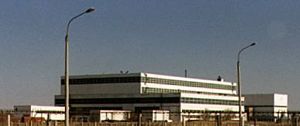 |
MIK Assembly BldgExternal view of the colossal MIK N1 / Energia / Buran Horizontal Assembly Building.Credit: © Mark Wade |
|---|
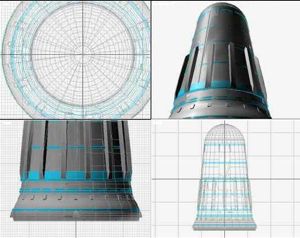 |
N1 Stage 1Views of computer model of N1 first stageCredit: new |
|---|
 |
N1 propellant tankN1 propellant tank dome, used as gazebo at BaikonurCredit: © Mark Wade |
|---|
 |
N1 5L night launchCredit: RKK Energia |
|---|
 |
N1 on pad at nightCredit: © Mark Wade |
|---|
 |
N1 BCredit: RKK Energia |
|---|
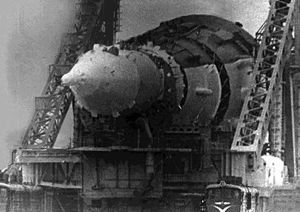 |
N1 5L RolloutCredit: © Mark Wade |
|---|
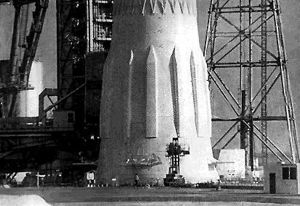 |
N1 7L on padNote modified first stage fairings on N1 7LCredit: RKK Energia |
|---|
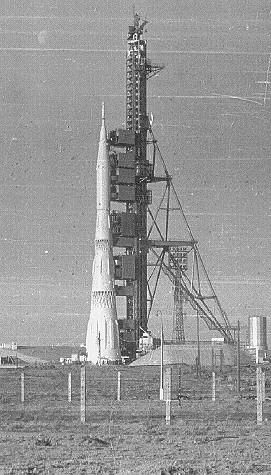 |
N1 vehicle 7LCredit: Ed Cameron |
|---|
 |
N1 second stageN1 second stage undergoing dynamic test. This is believed to be the N1M version of the stage, showing the insulation panels to protect the cryogenic propellants.Credit: © Mark Wade |
|---|
 |
N1 test modelN1 dynamic test model in the stand at Tsniimash.Credit: © Mark Wade |
|---|
 |
N1 3L on padCredit: RKK Energia |
|---|
 |
N1-L3 TowerDetail of tower of N1-L3 7LCredit: RKK Energia |
|---|
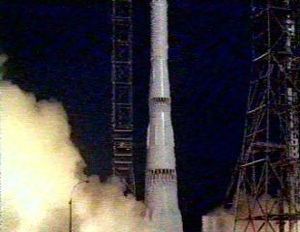 |
N1 6L lift-offCredit: RKK Energia |
|---|
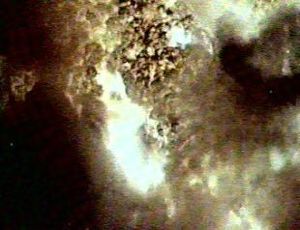 |
N1 5L ExplosionFinal explosion of N1 5L, destroying pad.Credit: RKK Energia |
|---|
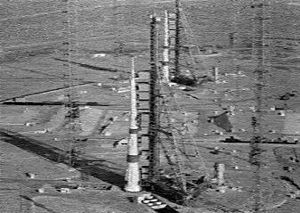 |
2 N1s Mounted on PadCredit: RKK Energia |
|---|
 |
N1 5L Falls BackHaving just cleared the tower, N1 5L falls back onto the pad at a 45 degree angle.Credit: RKK Energia |
|---|
 |
N1 5L clears towerN1 5L Clears the tower but falters as the KORD system incorrectly shuts down engines.Credit: RKK Energia |
|---|
 |
N1 5L lift-offEngine ignition of N1 5L.Credit: RKK Energia |
|---|
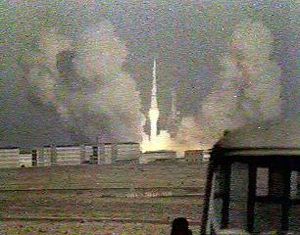 |
N1 7L lift-offN1 7L rises over the apartment blocks of the workers that built itCredit: RKK Energia |
|---|
 |
N1 subassembliesN1 tank sections were built in Samara, then shipped to Baikonur for assembly of the launch vehicle.Credit: RKK Energia |
|---|
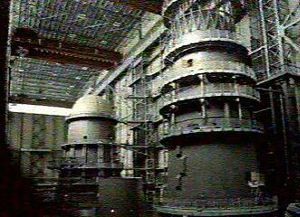 |
N1 stagesN1 stages in the assembly hallCredit: RKK Energia |
|---|
 |
N1 tank assemblySubassemblies from Samara were built up into stage bulkheads on assembly jigs at Baikonur.Credit: RKK Energia |
|---|
 |
N1 boattail assemblyBase of N1 first stage in assembly jigCredit: RKK Energia |
|---|
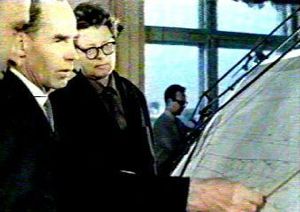 |
N1 engineersN1 engineers study drawingCredit: RKK Energia |
|---|
 |
N1 Engine firedN1 Engine fired on test standCredit: RKK Energia |
|---|
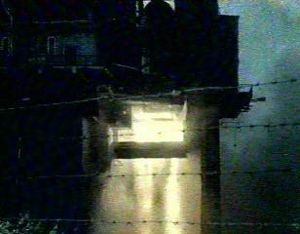 |
N1 Upper StageN1 Upper Stage firing on test standCredit: RKK Energia |
|---|
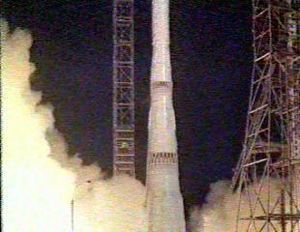 |
N1 6L Lift-offCredit: RKK Energia |
|---|
 |
N1 6L ignitionCredit: RKK Energia |
|---|
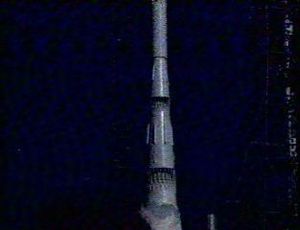 |
N1 6L Engine StartCredit: RKK Energia |
|---|
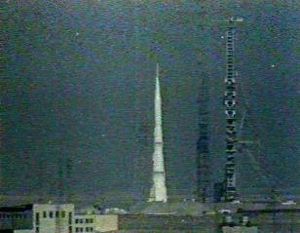 |
N1 7L Lift-offCredit: RKK Energia |
|---|
 |
N1 MIK Assembly HallCIA's National Intelligence Estimate of March 1967Credit: RKK Energia |
|---|
 |
N1 Model TestCredit: RKK Energia |
|---|
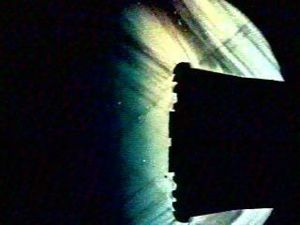 |
N1 Wind Tunnel TestCredit: RKK Energia |
|---|
 |
N1 Subscale ModelCredit: RKK Energia |
|---|
 |
Model of N1 padCredit: RKK Energia |
|---|
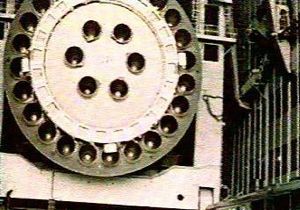 |
N1 RolloutN1 Rollout - base of boosterCredit: RKK Energia |
|---|
 |
N1 RolloutN1 Rollout - view from inside MIKCredit: RKK Energia |
|---|
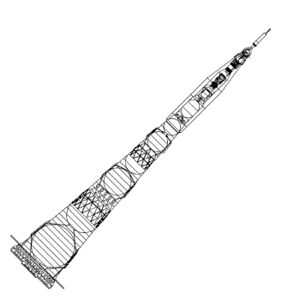 |
N1 CutawayCredit: © Mark Wade |
|---|
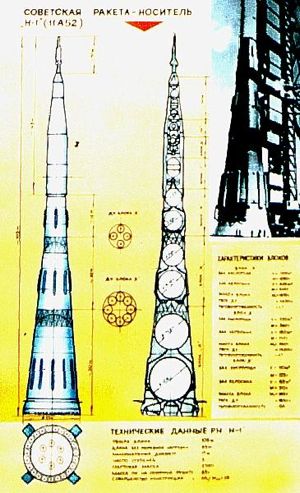 |
N1 Diagram KorolevDiagram of N1 launch vehicle at Korolev.Credit: Jakob Terweij |
|---|
 |
N1 CutawayDimensioned Russian cutaway drawing of N1 launch vehicle. |
|---|
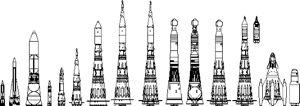 |
N1 VariantsN1 Launch Vehicle FamilyCredit: © Mark Wade |
|---|
 |
YaKhR-2 exteriorYaKhR-2 Nuclear-powered Launch VehicleCredit: © Mark Wade |
|---|
 |
N1 - 1962N-I as per draft project, 1962 |
|---|
 |
N-IIGR - 1962N-IIGR Multi-Warhead FOBS, 1962 |
|---|
 |
N1 early conceptCredit: © Mark Wade |
|---|
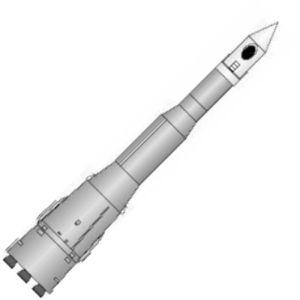 |
N-III 1962 |
|---|
 |
R-56 test modelR-56 dynamic test modelCredit: © Mark Wade |
|---|
 |
N1-L3 - 1964N1-L3 as per advanced project, 1964 |
|---|
 |
N1 Late VersionsLate versions of N1: from left: N1F; N1M; N1F with Block S, R upper stages; N1F with Block Sr upper stage; Airbreathing N1 for MOK support; Kistler |
|---|
 |
N-IF VariantsN-IF Versions, from left: N1-L3; N-IF; N-IUV-III; N-IFV-III; N-IFV-III,II |
|---|
 |
N-IFV-II, IIIN-IFV-II, III of 1965 |
|---|
 |
N-IMV-II,III |
|---|
 |
N-IUV-III |
|---|
 |
N-IMV-III |
|---|
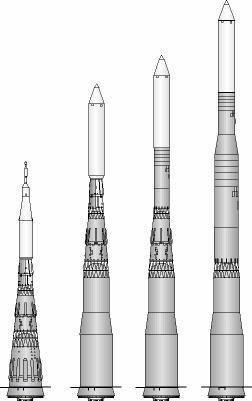 |
N-IM 1965N-IM version of 1965 |
|---|
 |
N1FV-IIIN-IFV-III design of 1965 |
|---|
 |
N-IF - 1965N-IF - 1965 design |
|---|
 |
Cutaway of N1Credit: RKK Energia |
|---|
 |
N1M cutawayCredit: © Mark Wade |
|---|
 |
N1F - SrN1F with Sr Lox/LH2 upper stage |
|---|
 |
N1F - 1974N1F - 1974 Configuration (N1 s/n 8L) |
|---|
 |
N1M 1974N1M of 1974 |
|---|
 |
N1M - Sr |
|---|
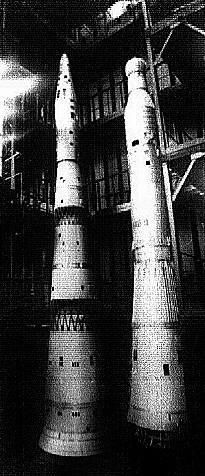 |
N1 and N-1MN1 and N-1M Dynamic test modelsCredit: © Mark Wade |
|---|
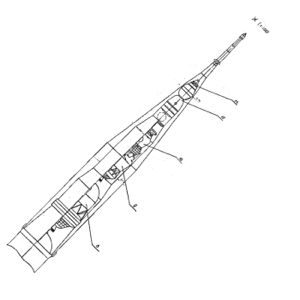 |
L3 CutawayDimensioned Russian cutaway drawing of L3 manned lunar landing complex. |
|---|
 |
SuperraketCredit: © Mark Wade |
|---|
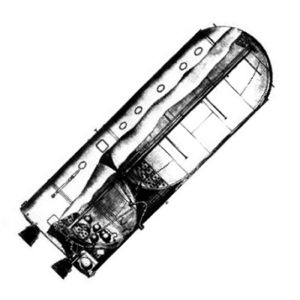 |
Blok SRCredit: RKK Energia |
|---|
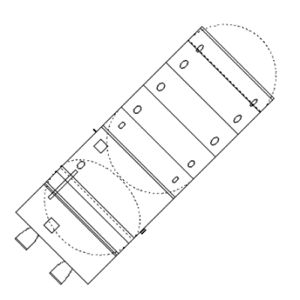 |
Blok SRCredit: © Mark Wade |
|---|